









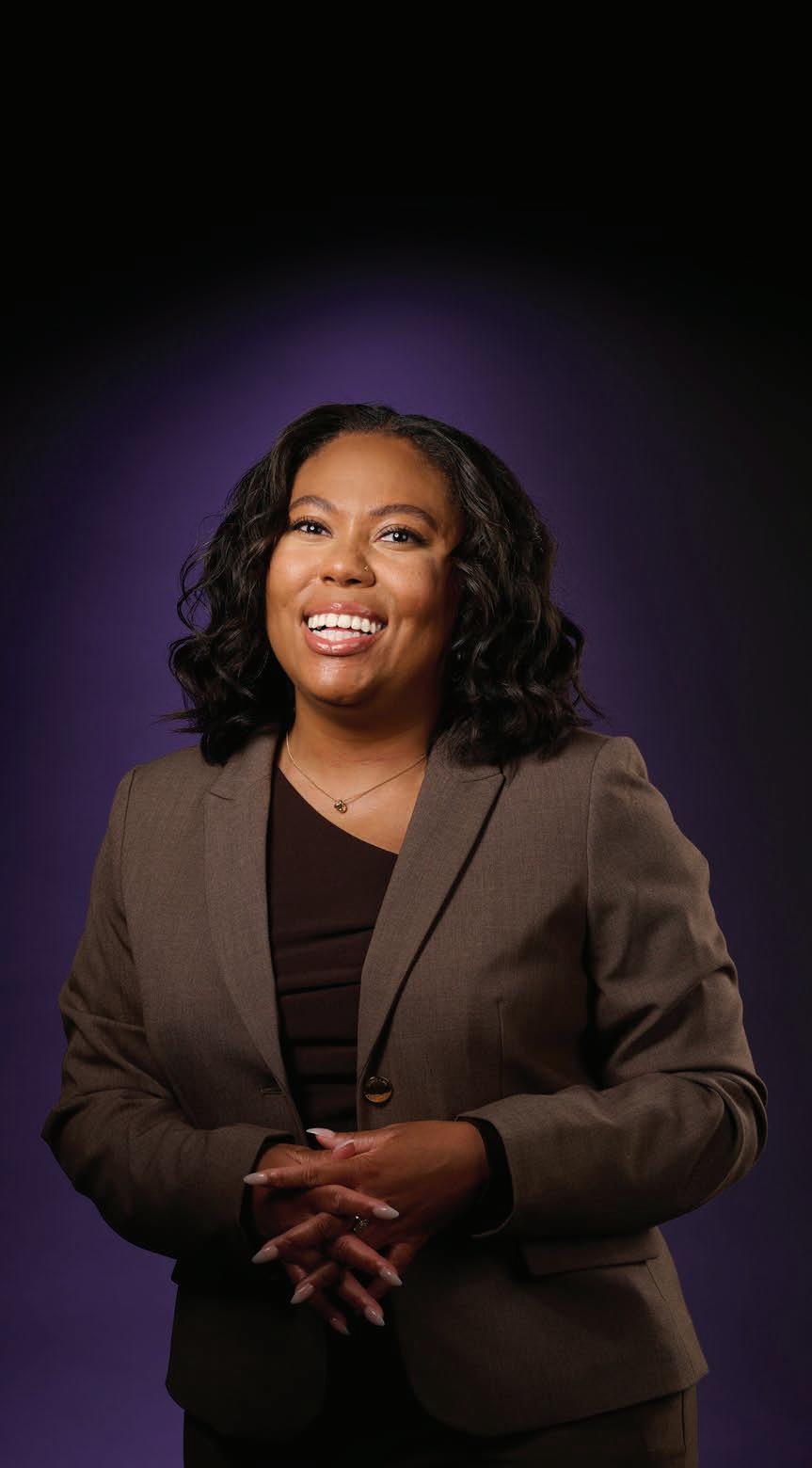
Crain’s 40 Under 40 honors the exceptional achievements of young professionals across diverse industries and showcases dynamic leaders shaping their communities. Meet the next generation of leaders guiding Northeast Ohio into the future. PAGE 10












Crain’s 40 Under 40 honors the exceptional achievements of young professionals across diverse industries and showcases dynamic leaders shaping their communities. Meet the next generation of leaders guiding Northeast Ohio into the future. PAGE 10
By Paige Bennett
Cleveland Clinic aims to have “the most advanced spine center in the country” through the deployment of AI technology that predicts patients’ probable outcomes before they undergo a procedure.
Through a partnership with the Health Data Analytics Institute, a Massachusetts-based health care data analytics company, the Clinic has introduced new technology that creates predictions on patient outcomes, including mortality, morbidity and the risks of cardiac or pulmonary complications.
The tech also predicts the length of a patient’s hospital stay and their likelihood of readmission.
Physicians can use this information to take preventive measures for high-risk patients like consulting with an internist, ordering additional testing or postponing a surgery altogether, Dr. Thomas Mroz, a spine and orthopedic surgeon at Cleveland Clinic, said in a phone interview.
The organizations say their objective is to put processes in place that can reduce complications and adverse events related to surgery. The platform combines Clinic data on patient outcomes with technology from the Health Data Analytics Institute.

“We're targeting a number of use cases in those settings, specifically looking at optimizing patients before they get admitted to the hospital for a procedure and trying to not only optimize their admission process, but also understand all their risk factors,” said Nassib Chamoun, founder of the Health Data Analytics Institute.
The organizations have had a relationship for multiple years, Chamoun said, working together on several papers focused on using predictive models to stratify high-risk patients.
With this project, they have put the technology in the hands of the clinicians working in the health system’s spine center.
Having this tool at their disposal can aid physicians in their clinical decision-making, Mroz said. A number of different procedures are performed in the spine, ranging from discectomies to spinal fusions. Physicians must consider many discrete data points in their decision-making process, Mroz said, but it’s impossible to know all
these data at once without a tool like this.
Chamoun said the tech helps a patient’s clinical team share with them all their options and potential risks when they go in for a consultation for a procedure.
“It also provides every member of the care team, once they decide to proceed with surgery, with a risk profile for that patient that's quantitative and that's consistent across their journey,” he said.
Mroz said this technology is helping transform the way clinicians diagnose and could help the Clinic’s spine center become the most advanced in the U.S. The move comes as AI continues to take on a larger presence in the health care system. Earlier this year, the Clinic hired its first chief AI officer, and President and CEO Dr. Tom Mihaljevic said the system had begun exploring AI in patient-caregiver interactions during his State of the Clinic address in January.
Chamoun said there is a massive data burden on today’s clinicians.
“We’re reducing their time in the electronic health record and shifting it to focusing on personalizing care for patients,” he said. “That’s a more joyful way to practice for them, less burdensome, and ultimately better for the patient and their outcomes.”


By Dan Shingler
Akron has a big, newly expanded manufacturer.
What it doesn’t have is any signi cant space left at its once defunct Chapel Hill Mall, which is now a full industrial park, as that manufacturer has taken the nal spot.
OnQ, a California-based maker of security displays for electronic devices — those various mounts, boxes and cords that keep people from walking away with phones, tablets and other shiny toys — has taken the last big space in the mall.
e company occupies all of a former JCPenney store, as well as a portion of the former mall’s food court. It consolidated its manufacturing operations from California and a former Toys R Us store on Romig Road in Akron to the former mall, said OnQ founder and CEO Paul Chapuis.
At the old toy store, it had about 50,000 square feet of space and it had about 30,000 square feet in California. Now it’s got more than twice that amount of space to work in.
“We had outgrown our space some time ago,” Chapuis said. “We now have 200 (thousand square feet), which is a nice number.”
e company employs approximately 100 people at the site. About 55 of them are full time, and the rest are temporary workers who often are hired during busy times, such as before the holiday season when production ramps up, Chapuis said. (With a new iPhone out this year, the company has been particularly busy).
e site is also where OnQ does all of its prototyping, though design and sales are still done in California where it kept 9,000 square feet of mostly o ce space. Unique products
OnQ moved everything else to Chapel Hill in phases and was done before the end of October, Chapuis said.
e CEO spends about a week
per month in Akron but is considering moving from California himself.
“I’m falling in love with this place. I love the little neighborhoods of Stow and Hudson,” he said.
But there’s ample reason for the company to keep some of its operations in California’s San Francisco Bay area. e company’s sales and design people regularly interact with its customers and makers of the products it protects, many of whom are big tech companies in California, such as Apple.
Almost every device requires a unique design, Chapuis said, because they have to look good, their screens have to be bright and, in many cases, touchable — and every button has to be accessible.
OnQ doesn’t provide security for devices in Apple stores — store employees are responsible for security and devices remain untethered — but if you check out an Apple product elsewhere, there’s a good chance it’s held in place by an OnQ device.
“If you’re buying an Apple product from Costco, whether you’re in Germany, France or Japan (or the U.S.), those displays come out of Akron,” he said, citing one of his big clients, among other major retailers.
And, for production, there are reasons to be in Akron, too, he said, not the least of which is trafc and interstate access.
Many big retailers have a lot of display space for electronics, so OnQ has to make big, multi-truck shipments. Walmart, for example, has about 120 feet of display space, per store, to protect.
“Which means there’s 480,000 linear feet of displays that we manage for them,” Chapuis said.
So, when the company ships to Walmart, it sends out enough devices to cover all of the electronic devices in that space, which equates to more than 90 miles of display space.
Big rollouts for a customer like that can involve more than 100 semi-tractors and trailers, and
By Joe Scalzo
Say Yes Cleveland Executive Director Diane Downing, who has overseen signi cant growth for the organization since its launch in 2019, announced she will retire at the end of the rst quarter of 2025.
“A great deal has been accomplished over the past six years,” Downing said in a news release, “and now it is time for a new person to take the organization to the next level.”
Say Yes Cleveland’s executive committee will be working to develop a search process over the coming months to identify her successor.

even a recent refresh of devices for Lowes required more than 30 trucks.
“If we tried to do that in the Bay Area, we’d shut down tra c,” he said.
Chapel Hill Mall is virtually unrecognizable from its days as a retail haven for Akronites and equally unrecognizable from its last days as a mall, when its walkways and stores were nearly as empty as its vast parking lots.
Industrial Commercial Properties, or ICP, purchased the mall in 2021, has given it a complete remodel, and now leased it out to OnQ and other big tenants such as Driverge, the manufacturing and customization arm of MobilityWorks, a Rich eld-based company that makes wheelchairaccessible vans in 155,000 square feet at the site.
“ e entire mall is now full. e only piece left is a small space that used to be a Sears Tire Center,” Chapuis said. “If you look at the parking lot it’s almost as full as it was when it was a mall.”
If anyone is happier than Chapuis and possibly ICP about OnQ’s move, it’s probably Akron Mayor Shammas Malik, who said the city has been working closely with the company since it came to town in 2013.
“We’re proud to have played an important role as the company grew, expanded to multiple locations, and became one of the most successful companies in the retail display industry,” Malik said via email. “My administration is committed to cultivating a business climate that attracts and retains businesses like OnQ to put roots down in our community. When businesses like this thrive, we all bene t. And the fact that they were able to repurpose 140,000 square feet of the former mall (including the old JCPenney and part of the food court) shows that there is life in this space yet and we’re excited to continue seeing how this location is utilized.”
Say Yes Cleveland launched in the city in January 2019 as a local chapter of the national Say Yes to Education program.
Under Downing’s leadership, the organization’s scholarship fund expanded from $88 million to $106 million, securing college or career training scholarships for quali ed graduates of CMSD and partner charter schools for at least the next 25 years.
Since 2019, more than 3,000 students have utilized these scholarships.
Downing also spearheaded the rollout of support services across all 104 CMSD and partner charter schools. Say Yes Cleveland’s services, including the addition of a Family Support Specialist for every school, are designed to help students stay on track and ensure they graduate ready to use their scholarship opportunities.
“Say Yes Cleveland evolved and adjusted to substantial changes since we launched in 2019,” she said. “Despite challenges, we have stayed on course, met the benchmarks set for us at launch, and provided concrete, impactful as-
sistance to tens of thousands of students and families. I’m very proud of what we’ve been able to accomplish over the rst years of Say Yes Cleveland, and I know the foundation we’ve built sets Say Yes Cleveland up for a successful future.”
Before joining Say Yes Cleveland, Downing held several roles in the public and private sectors, including senior vice president of corporate a airs at Huntington Bank, Cleveland district director for U.S. Sen. George Voinovich, and key positions in the administrations of Mayor Michael White and Mayor George Voinovich. She was the project manager for the City of Cleveland for the construction of Cleveland Browns Stadium (now Huntington Bank Field) and held various leadership roles with the Cleveland Browns organization, including vice president and stadium operations director.
Originally from New York, Downing moved to Cleveland in 1977 after graduating from Vassar College to work for then-County Commissioner Seth Taft. She and her husband, Tom Corrigan, live in the Edgewater neighborhood. ey have three adult children: Deirdre, Sarah and omas.












By Stan Bullard
e Hertz Investment Group name has been struck from the deed for Fifth ird Center, downtown Cleveland’s seventhtallest building, at 600 Superior Avenue East.

Instead, the building’s ownership, as of ursday, Nov. 7, is an a liate of Prime Finance, the San Francisco-based lending and investment concern, according to Cuyahoga County property records. Prime Finance took e ective control of the 27-story building at an auction in 2023 in New York City.
Ending legal limbo could clear the way for the building to be sold and, at a minimum, directs county property tax bills to Prime Finance's San Francisco address from Hertz headquarters in Los Angeles.






Hertz continues to own the North Point o ce complex and Skylight O ce Tower at Tower City. e concern is the nancially distressed owner of a portfolio of o ce skyscrapers in secondary markets that realty data provider CoStar pegs as the single largest owner of such properties in the nation.
As a private equity-backed lending concern, Prime Finance has a liates that lend as well as other a liates that make property investments, among others.
Fifth ird Center ownership was shifted to a new company called PFP 6 Fifth ird Owner LLC from Hertz Cleveland 600 Superior LLC, which Hertz and Prime formed in 2019 as Prime provided a $54 million mortgage to re nance the property from a prior lender, Ladder Capital Management of New York City. e
latest move ended the de facto control of the building since a UCC Auction, a form of foreclosure proceeding, in 2023.
Although no money changed hands in the latest transaction, according to county records, it is also listed as a sale and change of ownership by CoStar.
Fifth ird was Hertz’s rst downtown Cleveland investment in 2015 when it paid $54 million to buy it from Tier REIT, a Dallas real estate company.
e building dates from 1989 and is 24% vacant, according to CoStar. Leasing and property management companies remain unchanged. Respectively, they are JLL Inc.’s Cleveland o ce and Farbman Group of South eld, Michigan.
Prime Finance did not return three phone calls requesting comment by 3:50 p.m. Friday, Nov. 8.
By Stan Bullard
Acquiring the Avon Lake Towne Center shopping center and 6 adjoining acres of land zoned for apartments cost $5.95 million for the joint venture formed by DeHoff Development Co. and Lemmon Development, according to Lorain County land records.
e North Canton-based developer duo acquired the 99,000square foot shopping center, which has an empty grocery store space with 59,000 square feet of space, on Nov. 1 for $4.15 million.
e adjoining land traded for $1.8 million.
e properties are at 32814
Walker Road in Avon Lake. e seller was Kopf Properties of Avon Lake, a commercial arm of Kopf Builders of Avon Lake.
Beth Borda, vice president of DeHo , said in a phone interview Monday, Nov. 11, that the company has elded additional phone calls about the empty grocery store space. She said the joint venture is working on a design to renovate the center, which was built in 1998.
The grocery store space was emptied when Tops pulled out of Northeast Ohio in 2006. The supermarket space only became available for reuse last December after the Tops lease expired.
e apartment land could accommodate as many as 120 units. A timeline for developing the apartments has not been set. However, the updating of the plaza, after undergoing city review, is scheduled for next spring, Borda said.
e sale by family-owned Kopf follows the death of its founder, Herman R. “Bucky” Kopf in late 2023. e principals announced the planned transaction in October.
DeHo and Lemmon have partnered on multiple developments and purchases and have a portfolio that includes eight shopping centers and 1,500 units of apartments.
By Stan Bullard
Skyline Investments (SKLN.TA) may draw renewed interest from potential buyers of the Hotel Cleveland and Hyatt Regency Cleveland downtown after its latest corporate update: It's exiting the hospitality business.
The Toronto-based company, which is traded on the Tel Aviv Stock Exchange, announced the change in direction in a securities filing on Monday, Nov. 4.
"The company will not continue to develop and will not turn to new opportunities in the field of its hotels and resorts in North America" and "will examine from time to time the most suitable timing and price for the realization of existing assets," according to a Google Translate translation of the filing from Hebrew.
The company has good reason for looking at alternatives. It recently sold 11 Courtyard hotels it owned in the U.S. and has said it is looking to shed another three it still owns.
And then, it has the two landmark properties in Cleveland that it has for years made efforts to sell, with some publicly disclosed false starts.
David Sangree, president of Hotel & Leisure Advisors of Lakewood, said in a phone interview

that the filing signals another serious effort to sell the hotels and could whet the appetite of potential acquirers.
"It's a good time to sell the properties because the Cleveland hotel market has done quite well this year," Sangree said.
Sandip Thakkar, president of HSM Hospitality Management of Cleveland, agreed.
"It's been a booming year," Thakkar said in a phone interview. "And business downtown has been good a few years. And there are a lot of lookers out there
hunting new hotels."
A new owner could benefit from the recently completed $90 million updating of the Hotel Cleveland, which took two years to complete at the 491-room property on Public Square. The Hyatt has 293 rooms and an active hotel
business in the marble-floored, brass-appointed interior of The Arcade. A new owner also could seek upside by retenanting many empty storefronts on The Arcade's two lower levels.
CoStar, the online realty data portal, as of 3 p.m. Thursday, Nov. 7, did not show active efforts to sell the two Cleveland hotels.
The Hotel Cleveland has a market value for tax purposes of $11 million, but it has clearly not been revised to reflect the recent investment in the property. The Hyatt has a value of $16 million, according to county records.
Skyline ventured into the Cleveland and U.S. hotel market in 2011 when it paid $7.7 million for the Hyatt at a sheriff's sale concluding a foreclosure proceeding. It doubled down on downtown which it paid $20.5 million for the Hotel Cleveland, then a Renaissance Cleveland Hotel.
In later years, and with different corporate executives, the company bought the Courtyards that it just sold and started trying to exit the Cleveland market during the pandemic.
Blake Lyon, Skyline CEO, did not return a phone call for comment.
CoStar on Wednesday, Nov. 6, broke the story on Skyline's change in strategy.
When big-ticket perks are out of reach, consider boosting dental, disability and life insurance to increase employee satisfaction

Jim
Vice President, Specialty Products, Medical Mutual
As many companies bring staff back to the office, they risk losing employees to remote work opportunities. To retain talent, larger businesses are adding perks such as fuel reimbursement, paid childcare and catered lunches. However, some companies are reducing essential benefits and making other cuts to offer these perks, indicating that such incentives may not be affordable or sustainable — especially for small businesses.
The return-to-office challenge for smaller companies
For companies that can’t afford to offer extra perks to lure employees back to the office, retaining talented team members can be a challenge. Examining the practical benefits they already offer can reveal a solution. Employees consistently rank dental, disability and life insurance as highly valued benefits that complement health insurance and give their families peace of mind. Increasing the value of these ancillary benefits can be an easy and budget-friendly way to compensate for a
transition to working in the office and boost employee loyalty.
Key enhancements to consider Dental Benefits
• The plan design should reflect employees’ needs. If most employees only use their benefits for standard cleanings and exams, an employer might consider covering preventive services at 100%. If many employees have children, a higher contract maximum or orthodontia coverage may be appreciated.
• A dental plan with a strong network allows employees to maximize their benefits and pay less for their dental care. Companies should consider a plan with a network that gives their employees easier access to participating dentists no matter where they live, work or travel.
Short- and Long-term Disability Insurance
• Short- and long-term disability claims require expert guidance and long-term support. Companies can enhance this coverage by considering an insurer that gives employees direct access to a dedicated contact.
• Disability insurance involves complicated processes and paperwork. Moving this coverage to an insurer that handles administration can save a significant amount of time and frustration.
Life Insurance
• Since this benefit is utilized in difficult situations, easy access to expert guidance is crucial. If the current insurer requires customers to navigate a complicated phone system or website to reach a representative, employers should consider one that provides a smoother experience for employees and their families.
• Some life insurance plans offer value-added living benefits such as will preparation, ID theft resolution services and travel assistance. Adding these useful benefits can offer employees unexpected value.
Elevated ancillary benefits support a happier work environment
“Because ancillary benefits typically require less administration, boosting their overall value is an easy and affordable way for companies to offset transitions like returning to the office,” said Jim McGonagle, Vice President, Specialty Products for Medical Mutual. “Bundling ancillary with health benefits from a single carrier should also be considered, as some offer multi-policy discounts that can make it easier for smaller companies to provide higher-value benefits to employees.”
By focusing on enhancing the practical and sustainable benefits employees truly value, companies can create a supportive work
environment — even without the flashy, highcost perks that larger businesses might offer.
The value of a hometown health insurer
For a better experience, McGonagle encourages small companies to consider a health insurance partner that’s close to home.
“Direct access to local support can enhance the overall value of a benefits package for employees and their employer,” said McGonagle. “As the oldest insurance company based in Ohio, Medical Mutual has 90 years of experience serving Ohioans. Our customers appreciate the expert local service and hassle-free claims administration we provide through our 3,500 Ohio-based employees.”
More than 1.2 million Ohioans are covered by Medical Mutual’s health and ancillary group plans, which include dental benefits from Superior Dental Care (SDC) and life and disability insurance from MedMutual Life.
To learn more about how these benefits can help your company retain staff, contact your broker or account executive, or visit MedMutual.com/ Employers

A potential increase in steel prices could present challenges for companies that rely on the material
By Dan Shingler
As a regimen of new or increased tariffs on Chinese and other foreign products exported to the U.S. appears imminent during the next Trump administration, steel might be the product most closely linked to the economy of Northeast Ohio.
The most obviously affected is Cleveland-Cliffs Inc., the only major steelmaker left in Cleveland. Cliffs did not respond to requests to discuss potential increased tariffs on foreign competition, but it didn’t need to. The stock market spoke loud and clear on its behalf.
When the market closed on Election Day, Tuesday, Nov. 5, Cliffs was at $11.61 per share. When the market closed the next day, on which it was announced that the prince of tariffs had won the election, Cliffs was trading at $13.94. That spike of just under 17% was similar to what other steel companies experienced.
In short, investors think revenues of U.S. steel companies will rise, via either increased prices, increased volume or some combination of the two.
Increased revenues would, of course, be a good thing for Cliffs. They could also be good news for its more than 1,800 union employees in the flats, as well as for another 2,500 workers at its Middletown works near Cincinnati.
But if there’s one thing we’ve known about steel since it pushed the Bronze Age aside more than 3,000 years ago, it’s that it makes quite a double-edged sword.
Steel tariffs might do the same. While an increase in steel prices is good for producers, it can present challenges for companies that rely on steel to make their products. There are hundreds of companies spread across Northeast Ohio that buy steel made by Cliffs or other steelmakers in the U.S. and abroad, from big companies such as Parker Hannifin and Swagelok, to countless small machine shops, stampers and metal fabricators.
Some of them might get at least a temporary boost from tariffs, too. But over the past decades, as the U.S. has increasingly relied on imported goods, many of those companies already focus on markets such as military or defense contractors, which are bound to buy from domestic manufacturers. Others have focused on items that are difficult to import even without tariffs because of their size, weight or cost.
For them, this is a time of uncertainty, but many expect to see the price of the steel, and other metals, to go up.
“Most of our steel is domestically sourced, but a portion of the raw material is still imported, and some of our customers insist on U.S. content based on the nature of their work,” said Jeff Berlin, founder and CEO of Bridge Industries in Chagrin Falls, a $275 mil-

A regimen of new or increased tariffs on Chinese and other foreign products, like steel, appears imminent during the next Trump administration. | BLoomBERG
lion company whose subsidiaries around the country produce things such as tanks and heat exchangers for industrial customers.
“However, we believe the nature of the tariff program will put upward pressure on all metal pricing,” Berlin added.
Berlin said most of his customers turn to his companies for the quality standards they adhere to, not to mention that getting a big product such as an industrial propane tank or heat exchanger from Texas or the Carolinas is quicker and more reliable than ordering it from overseas. He’s not banking on increased market share from tariffs.
about retaliatory tariffs from other countries, which could make it difficult to compete in key global markets.”
Magnet, a state-sponsored manufacturing advocacy and consulting organization in Cleveland, sees similar challenges and uncertainties.
“Based on the effects of the last round of tariffs in the last Trump administration, the impacts of tariffs are complicated and mixed,” said Magnet CEO Ethan Karp. “Regarding steel, for some companies, like those producing steel, they will win by selling more steel at better prices leading to more profit and revenue."
“Tariffs will likely drive up costs for these raw materials, putting pressure on margins for impacted companies.”
Adam Artman, president and executive director of Cleveland Works
“We don’t see impact on our market share, as our competition is typically working with similar sources, and they are primarily domestic companies,” Berlin said.
“Many customers in our market have a 'no China/India' sourcing strategy ... mostly for fear of quality issues.”
Other manufacturers and their advocates are worried about the price increases they might see for their raw materials, including steel, or for the components they need to make their finished products.
“Tariffs will likely drive up costs for these raw materials, putting pressure on margins for impacted companies,” said Adam Artman, president and executive director of Cleveland Works, a network of about 300 manufacturers in and around Cleveland.
“Short term, it may come down to whether these costs can be absorbed or passed on to customers, neither of which is ideal," Artman said. "There may also be a concern
Karp added that downstream users of steel "will lose as their prices will increase — metal machine shops, construction, etc. Either those downstream companies using steel reduce their profit by eating the steel price increases or they pass it along to you and me as consumers. Deciding whether it is a net gain or loss is difficult because of all of these dynamics, but purely economically speaking as consumers, prices of steel-based products will go up.”
Some companies think it might be easier to pass along price increases to their customers than it was in the past. They, and their customers, have come to accept higher prices that are out of producers' control thanks to the pandemic and the supply chain issues it created.
“If Trump’s tariffs impact steel or aluminum, I think we will be able to pass these costs onto our customers with relative ease, unlike the situation in 2019 when Trump was president and imposed tariffs on Chinese-made materials,” said Jerry Zeitler, president of Die-Matic, a metal stamper of small precision parts in Brecksville.
“It took a while for the industry
to figure out how we should go about handling those increases in 2019,” Zeitler said. “Some customers pushed back with a vengeance, and as a result, we fired one or two (customers)."
Another question is whether tariffs are a long-term solution. They are intended to stave off foreign competition and spur domestic investment in manufacturing. But for that to happen, investors might need to be convinced that the tariffs are here to stay.
Tariffs can be justified when they fend off competition from nations that benefit from unfair advantages, such as child labor, lax environmental standards or government subsidies, said Ken Patsey, who formerly held Artman’s position at Manufacturing Works and now works to help manufacturers buy and sell their companies and assets. But he said they can have a negative impact if misused.
“Otherwise, they just create uncompetitive advantages that generally are not sustainable and therefore disruptive to both those who benefit and those who are hurt in the short term,” Patsey said.
As for the net effect on the Northeast Ohio economy, it’s tough to say, especially as no specific new tariffs or increases have yet been enacted.
“(It’s) difficult at this point to take a stance on the impact on our region specifically. Trump looks to support manufacturing generally, which is a positive,” Patsey said. “But the actions of his administration on trade in particular have mixed results for the sector with some winners and some losers."
Karp, at Magnet, tends to agree. He said tariffs could and should lead to more investment that will make manufacturing more efficient, but it’s too soon to know if that’ll happen.
“The big payoff for tariffs is when the beneficiary companies — steel companies in this case —
earn enough profits to not only increase steel production but to invest in automation to lower their costs so that the price of local steel goes down,” Karp said. “This is exactly what needs to happen with all manufacturers for the continued thriving of American manufacturing: more technology and automation. However, tariffs are a tricky way to make this happen because businesses worry that in four years, the next president may get rid of them.”
In the meantime, manufacturers are caught in a sort of limbo. Should they stockpile inventory in anticipation of price increases or possible supply-chain issues? Prepare their customers for price increases? Ramp up? Slim down? It’s too early to say and too early to react, some say.
“Trump has said he’s going to do so many things in his second term that it’s impossible to do them all in the first week or even first month. Thus, I’d rather take the wait-and-see approach,” Zeitler said. “And even if he implements a bunch of new tariffs, it’ll take some time before they take effect. Heck, Biden extended tariffs, raised tariffs and implemented new tariffs in May. So far, they haven’t had any impact on my business. Yet at the time, I thought they would.”
Artman, at Manufacturing Works, also is a bit uncertain.
“The overall immediate impact of tariffs will very likely be cost increases, whether absorbed by the business or passed on to the customer until supply chains can be reworked,” he said.
But Artman remains upbeat about the prospects for manufacturing here.
“With the uncertainty that comes with policy change, one thing is for sure: Ohio’s manufacturing industry is resilient,” he said. “As we continue to monitor the situation, our focus remains on identifying proactive strategies that support the manufacturing community in navigating this evolving landscape.”
By Jeremy Nobile
TerrAscend Corp., a multistate cannabis company headquartered in Mississauga, Ontario, has announced the signing of a de nitive agreement to acquire Ratio Cannabis, a dispensary in New Philadelphia, in a deal that signals more to come.
TerrAscend, which is publicly traded on the Toronto Stock Exchange (TSX: TSND, OTCQX: TSNDF), said the deal is valued at $10.3 million, which includes $5 million in cash, $1.32 million in stock and a seller’s note for $3.98 million bearing 6% interest with a two-year maturity.
e transaction is subject to regulatory approvals, which is a little more involved for a business new to the state. Company o cials estimate that the deal may close in six to eight weeks.
Ohio will mark the sixth state in TerrAscend’s U.S. footprint, which includes operations in California, Michigan, Maryland, New Jersey and Pennsylvania. e business marked its entrance to the U.S. market about ve years ago.
While TerrAscend is vertically integrated in some of those markets, CEO Ziad Ghanem likened
the expansion strategy for Ohio to Maryland, where the company has been focused primarily on establishing a retail presence for the last few years. It reached its regulatory cap of four dispensaries in Maryland in 2023.
Ghanem notes that TerrAscend has a few di erent brands for its retail arm. Its Ohio dispensaries will operate under the Apothecarium moniker — which seems to be a nod in part to the pharmaceutical backgrounds of Ghanem and TerrAscend Executive Chairman Jason Wild.
Ghanem said the company likes the Ohio market for several reasons, including its limited license dynamic, the state’s recent launch of adult-use and the way that a presence in the market helps complement the company’s existing footprint in the Northeast and Midwest regions of the U.S.
“Entering Ohio and expansion in the Midwest has long been a priority for us. With the acquisition of this well-situated and profitable dispensary, we will enter our sixth U.S. state through an accretive transaction at an attractive price,” said Wild in a statement. “ is acquisition is a great rst step to becoming a leader in this

emerging adult-use market.”
Ghanem said the company was exploring M&A opportunities with a variety of retailers — they had been eyeing dispensaries with between $8 million and $15 million in annual revenue — and ended up signing the deal with Ratio after a relatively fast due diligence period of just three weeks.
He added that there’s a “high chance” the business may announce at least one more dispensary deal in the coming weeks.
Ultimately, Ghanem said TerrAscend aspires to acquire its way to a now-permitted maximum in Ohio of eight dispensaries.
If some cultivation or processing licenses become available in the future, the company might consider acquiring those as well. However, that’s not a high priority in Ohio right now, Ghanem said.
He notes how the company has existing relationships with other MSOs in this market and how there is no shortage of product right now, which is a function of the medical market that’s been active here since 2019 and the buildup of product that occurred in the run-up to the launch of recreational marijuana sales in August.
Considering these dynamics,

Ghanem said there’s no concern of having an adequate supply of products to sell.
As far as other areas within the state TerrAscend wants to expand to, Ghanem said that goal is to build a network across Ohio in or near population centers, including the largest metros of Columbus, Cleveland and Cincinnati.
“We would love to have pins covering the state in a way that diversi es our presence,” he said.




TerrAscend is making its way into Ohio as the state enjoys a strong adult-use rollout. Since the launch of recreational sales, total monthly cannabis sales in Ohio have doubled.
TerrAscend announced its expansion into Ohio along with Q3 earnings on Nov. 6.
The company reported gross profit of $36.2 million for Q3 (down 4% from the prior quarter) on net revenue of $74.2 million (down 4.3% from the prior quarter).





By Joe Scalzo
Like Starbucks, Ace Pickleball Club wants to become everyone’s “third place” between work and home.
Only with dinks, not drinks.
The Atlanta-based franchise opened its first location in Greater Cleveland on Wednesday, Nov. 13, at the former Bed, Bath & Beyond Building in the Uptown Solon shopping center located at 6025 Kruse Drive, just off U.S. 422 and SOM Center Road.
The 40,000-square-foot facility offers 13 courts along with a dinking court (a warmup/practice court) and a stretching area.
“We want to be everybody’s third place, where they come and hang out and play pickleball,” said general manager David Munsell, who grew up about five minutes from the club in Orange. “It’s a great club and I’m very excited to be a part of it.”
The Solon location is the seventh overall for Ace, which expects to open three more nationwide this year and between 25-30 locations next year. Ace is the third major indoor pickleball facility to open in Greater Cleveland this year — the six-court Erie Pickleball Club (EPC) in Mentor opened in June and the 15-court Cleveland Premier Pickleball Club (CPPC) in Avon Lake opened in September — but Ace is

the region’s first indoor pickleball franchise.
There are more than 300 places to play pickleball in Cleveland — indoor and outdoor — but most facilities are either independently operated (like EPC and CPPC), attached to a public parks system or located inside a fitness facility that offers other amenities, like a YMCA.
“The Ace Pickleball Club way is about the optimal playing experience, so everything from the seven-layer cushioned court system to the lighting, it’s all meant for the optimal indoor pickleball experience,” said franchise owner Mark Milakovich. “When I was researching the pickleball club franchises, I landed on Ace because I really like
what they do compared to the other companies.”
Ace was originally supposed to open its Solon location in late winter or early spring of this year under a different franchise owner, which frustrated Milakovich because he had wanted to open a Cleveland location and felt Solon was the perfect spot.
“I was like, ‘Darn, that is literally the best place to go,’” he said. “So when his plans changed and he wasn’t able to execute on this, they (Ace) gave me the call to come and step in and I was thrilled.
“It was like the perfect alignment of the planets.”
Ace originally planned to start construction in February or March, but work didn’t begin until June 1.

Together, we can help achieve your financial and charitable goals. Call our Gift Planning experts at 216.444.1245 or email giftplanning@ccf.org
That delay didn’t hurt the franchise since Cleveland’s fall weather has been incredible, allowing Ace to time its opening just after the time change and just ahead of the snow.
“Literally, we were blessed, right?” Milakovich said.
Ace is open from 6 a.m. to 10 p.m. Monday through Saturday, and 6 a.m. to 6 p.m. on Sundays. While Ace is open to all skill levels — every club will have what Milakovich jokingly called “pickleball bros” — its focus is on creating a welcoming environment for beginners and intermediate players, he said. Its $119 membership fee is all-inclusive, meaning members don’t have to pay extra for court reservations or open play. They even have balls and paddles.
Ace has already sold 400 club memberships, with a capacity of around 1,000 members.
“The way our staff is trained and the way our club is designed, it’s a really welcoming environment,” Milakovich said. “It is kind of intimidating when you’ve never played before and you’re like, ‘Oh, everybody is so good here.’ We want people saying, ‘OK, I can get on this court. This is the right place for me.’”
Speaking of the right places, Milakovich’s choice of Cleveland was very intentional. Although he’s originally from California and now
works in Dallas for a commercial real estate company called the Covington Group, he’s very familiar with the market. Covington owns about 2 million square feet of property in Greater Cleveland, including Canal Place in Akron.
While many pickleball franchisees are focused on America’s growth markets — particularly the Southeast and Southwest — he views Cleveland as a “phenomenal market” for indoor pickleball, in part because it’s hard to play outdoors more than six months per year but also because it has a low cost of living compared to other parts of the U.S.
“When you look at the demographics for a location like this, it looks fantastic from the standpoint of disposable income,” he said. “Because gyms and fitness things are truly a recreational type of thing, you want that disposable income, and because of the lower cost of living, somebody who makes $200,000 a year here is very different than someone who makes $200,000 a year in Southern California. They live a very different lifestyle.”
While Cleveland caught the pickleball bug a little later than some other parts of the country, participation has exploded in recent years and Ace is poised to capitalize on that growth.
A net gain, you might say.
Gift planning is a powerful way to leave a legacy and make a lasting impact at Cleveland Clinic. Our experienced Gift Planning team can work with you and your advisor to achieve your personal and philanthropic goals. Together, we can integrate your charitable, family and financial plans with the mission of Cleveland Clinic to transform healthcare for our patients and shape the future of medicine around the world.

“Graduate medical education hasn’t kept pace with the need for more doctors. Philanthropy helps to bridge the gaps. It supports the infrastructure necessary for training the next generation of caregivers.”
roughout my career as a social service coordinator and member of the Ohio State House, I have always sought to uplift the people who are often left behind in my community. My commitment to their economic well-being is why I am happy to support the proposed merger between Capital One and Discover, along with the accompanying $265 billion Community Bene ts Plan (CBP).

Rep. Darnell T. Brewer (D-Cleveland) represents the 18th District in the Ohio House of Representatives.
I am also excited about the potential benefits of this plan because it was crafted with our communities’ needs in mind.
Capital One did not just write this plan in a room full of executives. They brought together organizations that have deep ties to our communities like the National Association for Latino Community Asset Builders and NeighborWorks America. Their involvement in creating this plan lets me know that its investments are targeted and will be impactful. is plan includes generous investments that will genuinely help transform our communities.
What excites me the most about this plan is its commitment of $200 billion in lending to lowand moderate-income (LMI) individuals and communities. is investment will be a signi cant step in expanding nancial inclusion to lower-income households in Cleveland and the surrounding areas.
e CBP is also great news for minority-owned businesses in Ohio and all over the country. e plan includes a $5 billion commitment to spending with diverse suppliers and of $15 billion for small business lending in LMI
communities. is will help Black entrepreneurs secure contracts that may otherwise be out of reach and empower them to continue building their American dreams, create jobs in their communities, and drive economic growth in Cleveland and throughout our state.
Another crucial piece of the CBP that addresses a pressing need in many Black neighborhoods across Ohio is the $44 billion pledge for community development nancing, including investments in a ordable housing. Access to stable, reasonably priced housing is essential for building robust communities and paving the way for upward mobility for Black and Brown households.
And that’s not all. is plan also recognizes the importance of Community Development Financial Institutions (CDFIs) as essential in the e ort to expand access to nancial services to all. e $600 million commitment to nonpro t CDFIs will further empower these organizations to serve our communities. is inux of capital will bolster e orts to expand a ordable housing, to support small businesses, and expand access to consumer lending, creating a ripple e ect of positive change throughout our communities.
ere is no doubt in my mind that the CBP will be a major victory for Cleveland and communities like it, but this plan can only be put in motion should the Capital One-Discover merger be approved. As regulators review the Capital One-Discover merger, I urge them to consider the positive bene ts the CBP will have on our country and allow the merger to become nal.

Paige Bennett's excellent Nov. 7 article on the proposed acquisition of Summa Health by private equity rm General Catalyst Health Assurance Transformation Corporation (HATCo) was very thorough.
It's worth noting, however, that many studies show that when private equity rms acquire hospitals, the results are bad for the local community.
According to a recent article in e Washington Post, a review of 55 studies has found that private equity investments were associated with up to 32% higher costs to patients and insurers.
Another study found that private equity-acquired hospitals have lower sta -to-patient ratios and fewer experienced or licensed sta members than other hospitals.
Celebrating 85 years of serving businesses like yours for four generations since 1939.

A recent Harvard Medical School study of Medicare patients at hospitals before and after private equity acquisition found that patients su ered 25% more hospital-acquired complications, including 27% more falls and 38% more bloodstream infections, post-acquisition.
Akron Mayor Shammas Malik and Ohio Attorney General Dave Yost should seek to avoid such negative outcomes if they allow the Summa Health acquisition to proceed.
Je Barge Cleveland



















Crain’s 40 Under 40 honors the exceptional achievements of young professionals across diverse industries and showcases dynamic leaders shaping their communities. For more than three decades, Crain’s Cleveland Business has highlighted CEOs, founders, innovators, community champions and others under the age of 40 who are making signi cant impacts. From government to real estate to health care, the 2024 class of 40 Under 40 honorees lives up to this heritage. Meet the next generation of leaders guiding Northeast Ohio into the future.




Photography by Jason Miller






Ciara Ahern has carved a business out of getting attention for her clients at Sixth Element, a creative agency she founded in 2021 that has an impressive list of clients, many from the hospitality or realty industry.
ere is no o ce for the company, which has about 10 employees, not counting herself, and she said she doubts there ever will be a need for one.
Ahern said she started Sixth Element because she saw the creative agency as a way for her to support herself and remain active working on client projects, from picking company names to packaging and strategy.
“As you climb in the ad agency world, with more responsibility, you spend more time managing budgets and schedules than working with clients,” she said. “ at’s what I enjoy.” e communications major from Ohio State University, who also attended Notre Dame College, worked in public relations for Global Prairie and as an account supervisor for Adcom, as well as working freelance gigs for Cleveland ad execs while she was traveling internationally. Among her clients in those jobs were the likes of Bayer, General Electric and Lincoln Electric.




tising 30 years ago, I think creative is 1% of the business now.”
Among her clients is wellknown chef Doug Katz, who said she did the website for his latest restaurant, Kiln.
“She is an amazing talent and has a great spirit,” Katz said. “She gives you great service on many di erent types of things, from logos to branding and photography. She’s very hands-on and was present when a photographer took pictures for our site. I’m also always on the go and don’t work from an o ce. I call her and she drops what she’s doing to take care of something.”
She also tackles some work that’s not typical ad rm fare. She serves as a fractional chief marketing o cer for Market Square Brewery, where her husband, Sam McNulty, is a principal, including name and concept refreshes for some of its places, such as Bright Side. She also did the creative work for Chicago-area real estate developer Harbor Bay’s website, as well as its INTRO timber mixed-use building in Ohio City.


Ahern enjoys gardening and recently took up piano, which she had studied until she was 8, and has taught herself how to play rock standards. She plans to make her stage debut soon. Ironically, she said she plays old music, while the music she listens to on her own is exclusively new music.

Typical of Sixth Element’s work is its own website, which has big, bold letters to call attention to things and lots of rollover graphics. Asked if it is an in-your-face approach, she agreed.





“I see it as helping my clients cut through the noise,” Ahern said. “I nd the creative process energizing and rewarding. I also see a need for a creative boutique. Compared to adver-












Ahern, who grew up in Bainbridge Township, said she enjoys rollerblading around Ohio City –- which she took up a few years ago for the rst time since she was in her teens -– and exploring Cleveland with McNulty on a scooter. at is, when they are not traveling. ey have already visited Cambodia, Morocco, Patagonia and made 10 trips together to Ireland.



















Head of AI and data science, Further
Arti cial intelligence is increasingly becoming a household name at home and across industries.
With more widespread uses of AI emerging, making this technology approachable will be vital for its continued growth, said Lakewood entrepreneur and data scientist Cal Al-Dhubaib.
Al-Dhubaib is the founder of Pandata, a fully bootstrapped startup that designs and builds machine learning and AI solutions for corporations and nonpro ts. Pandata’s specialization in highrisk environments such as nance and health care led to its acquisition by Further earlier this year.
e Atlanta-based AI consulting practice’s dedication to accessibility was a natural alignment for Pandata, noted Al-Dhubaib.
“I built Pandata on the core values of comfort with uncertainty and using plain communication, rather than hyper-technical language,” Al-Dhubaib said. “I saw that sense of collaboration at Further.”
Al-Dhubaib launched Pandata in 2016 after earning the rst data science degree ever conferred by
Case Western Reserve University.
A world-traveled speaker and AI advocate, Al-Dhubaib helps corporations and nonpro ts use machine learning tools to solve problems and discover new e ciencies.
Yet, moving from the startup realm to a large enterprise involved some acclimation, Al-Dhubaib said.
“ e biggest change is from running a business -- where I’m nding customers and bringing on talent –- to spending more time evangelizing,” he said. “It’s a big adjustment learning to just collaborate with more team members and stakeholders, but it’s nice to let go of some of the operational details.”
Bill Trainor, managing director of Cleveland venture capital rm Mutual Capital Partners, has served as a mentor to Al-Dhubaib ever since meeting the young innovator at the LaunchHouse co-working space. Trainor advised Al-Dhubaib on the purchase agreement with Further, and their ongoing relationship revealed a tireless networker unafraid to set ambitious goals.
“Cal has a passion for life and travels the world professionally, but enjoys it personally, as well,” Trainor said. “His work ethic is ingrained in life as he seamlessly
mixes work with pleasure, staying positive despite constantly changing time zones, languages, travel challenges and ongoing customer demands.”
Al-Dhubaib’s new role with Further has not prevented him from advocating for AI’s abilities overseas. As an industry leader, storytelling is a valuable skill when parsing AI’s potential alongside more realistic expectations, he said.
Although building those bridges requires showcasing the tech’s practical uses, headline-grabbing projects like an upcoming collaboration with a major consumer brand continue to motivate him.
Nor do leaps in the technology have to be relegated to the coasts -- Al-Dhubaib sees exciting research taking place right in his backyard.
“It’s been an uphill battle, but when I was looking for talent at Pandata, there were 150 data scientists in the whole region,” Al-Dhubaib said. “Now, there are over 1,000, and lots of high-tech startups getting incubated in our space. Exiting an AI-based company and now working with major brands shows there’s room for other companies like this in Ohio.”
Douglas J. Guth



























Vice president, Polymer Industry Cluster, Greater Akron Chamber
He just might be Akron’s $100 million man.
Not by himself, of course. Greater Akron Chamber Vice President Brian Anderson would be the rst person to say that he had a lot of help and guidance in his work heading up the chamber’s Polymer Industry Cluster.
But most people, including his boss, will tell you that Anderson breathed re into the chamber’s e orts to develop the cluster and win federal grants to fund it — most of which he did when he was the chamber’s head of research.
“He didn’t come to do this work; he came to do general research and economic development stu for us,” said chamber President and CEO Steve Millard.
In fact, Anderson wasn’t sure what he wanted to do when he came to the chamber. He was working in banking and just knew he wanted to make a bigger impact on his community and hometown.
“ ey created a new position for me as senior director of research,” Anderson said. “I wound up being a special projects person.”
One of those projects was to determine the potential of a polymer cluster in and around Akron.
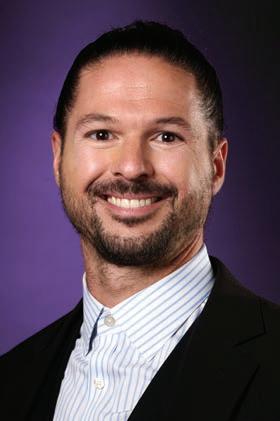
million in federal funding for its e orts. It lost out, but that might have been a good thing.
Anderson and the chamber refused to give up and kept developing the cluster and applying for funding. is year, their efforts paid o and the dam of federal funding burst and the state jumped into the rapids.
Akron won $51 million in federal funding for the cluster in July. e state of Ohio then awarded it another $31 million in September. Combined with matching funds from cluster participants, Millard and Anderson said the e ort now has about $100 million behind it, and Anderson already has a list of companies looking to relocate or expand in the region to take advantage of the federal support. Millard said he’s been very pleased, but not necessarily surprised by Anderson’s commitment, or his success.







e chamber determined that Akron could de nitely serve as the hub for an industry cluster of companies heavily involved in polymer research, engineering and production, which were already in place around the city and across Northeast Ohio.
“Brian has done a really nice job of helping us to take this from an idea and a concept to something we’re really having a big regional impact with,” Millard said.
Big, indeed.
In 2022, the chamber-led initiative was a nalist to win $17
“He’s an Akron homer — he grew up here, lives here, loves the community and believes in the community, and I think this is very rewarding work,” Millard said. “And people like working with good people — and aside from being someone who’s smart and works hard, Brian’s just someone who’s good to be around.”
—Dan Shingler



President and executive director, Manufacturing Works
Shaker Heights resident Adam Artman got a big new job this past spring. He took the helm of Manufacturing Works in March and now runs one of the top manufacturing advocacy and support organizations in the state.
And everybody saw it coming.
Artman had been hired by former head of the organization Ken Patsey, who said he saw something special in the young man who became his protégé almost as soon as they met.
“I met Adam when he was at OhioGuidestone, and we were developing a program together. At the end of the project, I told him, ‘We’re going to be working together again someday,’ ” Patsey said. “A year later, I needed to hire a new leader to take over as vice president of workforce development and gave him a call. Fortunately, I caught him just before he was ready to accept a new job with another organization.”
Artman’s memory of that day is just as clear.
“Ken leaned over to me and said, ‘We’re going to work together one day.’ We were in a meeting together. About a year later, I was ready to leave OhioGuidestone,” Artman said. “I said, ‘Hey, Ken, I think I’m ready to go to a smaller organization. How serious were you?’ About a year later, I was working with Manufacturing Works.”
Artman joined Manufacturing Works as head of workforce development. He’d already gotten a taste for the organization and what it does while he was helping OhioGuidestone win grant funding and train people for manufacturing, in partnership with Manufacturing Works, using augmented and virtual reality. He also got indirect exposure to manufacturing growing up, he said, while his father was a con-

sultant working on logistics for Andersen. But that was nothing compared to what he’s learned since, he said.
“I grew up around manufacturing-related things, but for the most part, my experience with manufacturing comes from Manufacturing Works.”
Now he’s overseeing a sta of 19 and serving more than 300 members of one of the most important sectors of Northeast Ohio’s economy.
Artman said he couldn’t be happier — he’s got a job he loves, along with a wife, Jessica, and two
children, Isla and Noa.
He’s poring over data — something he loves — working with a new strategic plan he recently devised and working to update the organization’s infrastructure and increase its reach.
Artman said he doesn’t think he could’ve been any better equipped for his new job, with his experience, an MBA and a deep understanding of his organization instilled in him by his predecessor.
“He prepared me well,” Artman said of Patsey.
—Dan Shingler
Kumar Arora is a serial entrepreneur whose eclectic and wideranging work de es easy categorization. Under the banner of his parent company Arora Ventures, the North Royalton native has invested in industries encompassing fashion, e-commerce, entertainment, marketing and consumer packaged goods.
Among Arora’s varied endeavors are Sora, Cleveland Kitchen, Innovation Chemical Technologies and the FutureLAND technology and culture conference. A constant pursuit of innovation has him seeking investments that contribute to Northeast Ohio’s overall development.
“It’s a left-brain, right-brain thing, where some aspects of the work are very analytical, while also giving me a chance to think creatively,” Arora said. “I like being able to create something people can touch, and love the idea of putting my head down to bring a concept to life.”
Recent collaborations between Arora’s ILTHY clothing brand and Cleveland’s professional sports teams embody this ethos, he said.
rough these partnerships, fans of the Cavaliers and Browns can purchase T-shirts, hoodies and other custom-made apparel in support of their favorite franchises.
As a hand-picked investor on LeBron James’ “Cleveland Hustles” reality show, Arora nanced a brick-and-mortar concept for Old City Soda, a local micro-soda company. en came organizing “MGK Day” for hometown rapperturned-rocker Machine Gun Kelly — the annual block party/charity was developed as a celebration of all things Cleveland.
Keeping a fresh perspective on each new project energizes Arora in his day-to-day work, he said.
Arora launched his portfolio company in 2010, since then focusing on partnerships o ering the biggest possible community

impact. An investment into fermented foods producer Cleveland Kitchen, for example, helped bring 80 new jobs to the city, he said.
While working with MGK and LeBron might make for splashy headlines, true leadership demands a wider focus, Arora said.
“It’s about inspiring others, and giving people hope to nd greater heights for themselves,” he said. “Cleveland is seen as the underdog, but big businesses can be built here, too. I want to share my success with fellow entrepreneurs and invest in the right projects.” It’s this all-encompassing vision that sets Arora apart from the region’s startup ecosystem, says Cleveland chef and restaurateur Fabio Salerno, founder and CEO of Salerno Group.
After meeting Arora at an entrepreneurial event at Lago, Salerno partnered with him on a sushi box concept he created for Sora, an upscale ghost kitchen that recently expanded to a seasonal pop-up on the East Bank of Cleveland’s Flats.
“Kumar has a brilliant marketing and branding mind,” Salerno said. “He allowed me to concentrate on the operations part of the business, and not have to dive into the layout of our marketing platforms.”
—Douglas J. Guth

Ben Austin started his career in public accounting, but he always wanted to be part of an organization that was dynamic and entrepreneurial.
It’s how he found himself joining SPR erapeutics, a Clevelandbased medical device company. Eleven years later, the organization has seen tremendous growth, and Austin has been instrumental to that success.
Austin began his career with SPR as an accounting manager, when the company had fewer than 20 employees and was still in the pre-revenue stage. He advanced the organization’s accounting, nance, information technology and human resources infrastructure as it went from the research and development stage to a full- edged commercial organization.
treatment.
Austin has led the closing of numerous equity and debt nancings, including the $85 million, which is SPR erapeutics’ largest capital raise thus far.
uring out how we continue to penetrate the markets and allow for patients to have access to this technology.”

“I don’t stand still,” he said. “We’ve got to move forward in some way, in some manner. I’m always looking for those opportunities and those challenges that we can tackle.”
In early 2024, he was promoted to his current role as chief operating officer. It was around this time the company, which now has more than 250 employees, announced it had secured $85 million in financing for a commercial expansion of its SPRINT PNS System, a non-opioid, minimally invasive option for pain
Austin grew up in Geneva. His father was an entrepreneur who ran nursing homes, which helped Austin develop a business mindset at an early age. He attended Kent State University, where he studied marketing before venturing into the world of accounting.
After more than a decade with SPR Therapeutics, Austin said he feels fortunate to continue being excited about his work.
“We’re still at the kind of the early stages of our commercial expansion,” he said. “I think that’s what keeps me excited, fig-
His biggest accomplishment so far was being part of the team that closed on one of the company’s first fundraisers in 2017. It was a transformational fundraising round for SPR Therapeutics, he said, that helped the organization move into commercialization and set it up for its future success.
Maria Bennett, the founder, president and CEO of SPR Therapeutics, described Austin as trustworthy, strategic and collaborative.
“He has taken on more and more responsibilities and has achieved and excelled at each
of those areas of responsibility and is leading now as my right hand within this organization, in which we continue to grow as a company year over year,” Bennett said. “He has contributed quite significantly to that growth, both from a contribution standpoint as far as raising money for the organization, but also ensuring that we’re operating efficiently.”
Austin said he lives in the moment and is focused on helping the company’s technology reach more patients and unlock its full potential. A Chagrin Falls resident, he enjoys spending time with his family and coaching his younger son’s soccer team.
—Paige Bennett
Executive director of enrollment management and strategic initiatives, Case Western Reserve University School of Medicine
When Brooklyn native Jason Buitrago arrived at the University of Rochester in 2003, he was the rst person in his family to go to college outside of New York City.
“It was uncharted territory for me,” he said.
Literally. Buitrago discovered during orientation week that he didn’t know how to navigate the college waters, so he stopped by the two o ces most familiar to him — “ e one that admitted me (admissions) and the one that gave me money ( nancial aid),” he said — and never really left.
Buitrago worked in both as a student and has spent his professional life working in undergraduate and graduate enrollment management and nancial aid. at includes his current role as the executive director of enrollment management and strategic initiatives at the Case Western Reserve University School of Medicine. “I think the part that still gives me incredible satisfaction in my role is those moments when prospective students feel connected,” said Buitrago, who is the son of Colombian immigrants. “Where they say, ‘Oh, my goodness, there’s possibility here. I can change my life. I can change my family’s life. I can make my dreams come true.’ at’s what happened to me and there’s a little bit of that ‘paying it forward’ mentality.”


And Buitrago always has inclusion at the top of his mind, said Stanton Gerson, dean of CWRU’s School of Medicine and senior vice president for medical a airs. Buitrago spearheaded the forma-







tion of CWRU’s Society for the Advancement of Chicanos/Hispanics and Native Americans in Science, helping the university become a destination for members of those communities, and has a knack for building connections and relationships across the entire spectrum of applicants and programs, Gerson said.
“He is the consummate matchmaker,” Gerson said. “Jason is well-regarded in the School of Medicine, as well as on campus, for his can-do attitude and bringing a sense of rigor to his work, while building a sense of inclusion when working with committees and his team.”
Buitrago believes his success lies in his ability to empower his various communities through his “multiple intersectional identities” as a Latino, a gay man, a cancer survivor, a higher education professional and community builder.
He’s also a community embracer, someone who says he fell in love with Cleveland before he had even o cially applied for a job at Case Western Reserve.
“I had never been to a city before where so many people had (their city) on all of their T-shirts,” he said, laughing. “I’m like, ‘Wow, people love this place!’ So, that’s what drew me. A little work, a little culture, a little something di erent (than Rochester) and a little bit of love as well.” at love has deepened in his ve years at CWRU, where he’s constantly reminding himself that he’s not only a piece of the university’s larger puzzle, but outside it as well.


“My little piece contributes to the greater good of not just the university, but Cleveland, Ohio, the country and the world,” he said.


—Joe Scalzo














Educational design lead, ThenDesign Architecture
Claire Bank got her start at
enDesign Architecture as a student and education remains central to her role at the Willoughby rm. at makes sense on the most basic level since enDesign specializes in work in K-12 schools.
Bank, who joined the rm 13 years ago as an intern while completing her graduate studies at Kent State University, is the rm’s educational design lead, a role in which she has overseen projects totaling nearly $300 million.
Some of the highlights: the new North Ridgeville High School, set to open in 2028; Wickli e’s pre-K to grade 12 campus; and North Royalton Elementary School.
Her educational ties are personal, too. Bank’s mom was a secondgrade teacher, and her dad was a school superintendent. (And, yes, she went to school in buildings where both worked.) Bank also is active in the ACE Mentor Program of Cleveland, which promotes diversity in the architectural eld and where she was 2023 Mentor of the Year, and College Now, a college-access organization that offers nancial aid counseling and scholarship/retention services.
Bank said growing up in an education-focused home gave her “an appreciation for how schools impact people and re ect the values of their communities.”



Designing schools and educational buildings, she said, enables her to help advance both “the educational mission and the social functions” of school districts by making sure facilities are designed to meet the needs of students and the community.
Education facilities, she said, should be aspirational and “make it easier to achieve” everything that students, teachers, administrators and residents want from their schools.
Bank enjoys the community input of working in the education space. A late-September meeting about the North Ridgeville project, for instance, was well-attended both in-person and online, and it generated “really thoughtful feedback” about design elements for the high school, which will be 340,000 square feet when completed.
She recently had a hand in a big-picture education project by serving as project manager for a comprehensive update of the Ohio School Design Manual (OSDM), a set of standard guidelines for the design of school facilities.
“As a family, we are very familiar with that document,” Bank quipped. She said she was “really excited” to be chosen to be part of the update, which included a new safety/security chapter, updated visuals and illustrations “to make it more approachable,” and some technology updates to make the manual more easily accessible.
Bank has taken an active role in mentoring young professionals at
Community development specialist, Federal Reserve Bank of Cleveland
For Andrew Bennett, ful llment comes in bringing people together, solving problems and helping others.
at’s why his expansive role as a community development specialist for the Federal Reserve Bank of Cleveland is such a perfect t — and why he’s excelling in that post.
“I’ve always been attracted to things where you have the opportunity to kind of move the needle to help improve people’s lives at the end of the day,” Bennett said. “What I’ve learned since graduating college is that I need to have that piece where I’m making some kind of contribution to society and groups of people.”
Bennett dabbled in a variety of endeavors prior to joining the Fed over three years ago. A former marketing manager for Within3, Bennett would later cofound Engage! Cleveland and KnowledgePost, as well as launch his own consulting business.

enDesign. One of her mentors at the rm was Je Henderson, a senior architect at enDesign, who said Bank brings a high level of technical skill to her work and combines it with “a very strong focus on community engagement.”
“Design is obviously what we do, but the most critical thing is to build and maintain relationships,” Henderson said. “Claire is exceptional at both.”
Bank and her husband, Patrick Bank, live in Cleveland’s Gordon Square district, near one of the rst school buildings she designed. Her interests include travel, horseback riding and reading — primarily science ction and fantasy.
She’s committed to working to address climate change. Bank is a founding board member of Brugmansia Ministries, an interfaith nonpro t focused on helping communities prepare for the e ects of climate change and migration.
—Scott Suttell
and representing the agency at policy summits, among myriad other responsibilities.
Bennett’s e orts already have made a measurable impac: the partnerships he has built throughout the Fed’s Fourth District enabled the agency to publish a Small Business Credit Survey on the Cleveland metro area this year for the very rst time.
“I love the idea of having a role that is community focused for those who are sort of underserved or not given the same opportunities in life that I have been and using my time and energy to help as many people as I can,” he said.
While Bennett has excelled in his career endeavors, there was a time in his early 30s when he grappled with nding satisfaction in his work. He fell into a rut, but later emerged after consulting with friends and mentors, attending a men’s retreat and coaching programs and reading personal development books — a big one for him was “ e Four Agreements: A Practical Guide to Personal Freedom.”




At the Cleveland Fed, Bennett oversees the strategy of the community development department, which involves building partnerships supporting community outreach and engagement initiatives
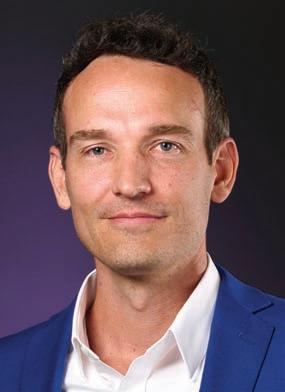
Craig James, co-founder of CatalystStrategies LLC.
“He helps you feel like you’re at the center when you’re with him, because you are,” James said. “ ough his aspirations of impact are larger than one person at a time, his one-on-one impact is signi cant, and his genuine love and compassion are the engines for that impact.”
In his free time, Bennett likes to travel. He also likes to seek out the solitude of nature and might be out gol ng, skiing or paddleboarding.
Now, he pays it forward by being a helpful guide or mentor to others.
Bennett volunteers and serves on a handful of boards, including Friends of Breakthrough Schools.
He’s even supported the mentors who have helped him, like
But creating a positive impact on others around him will always be his North Star.
“You’ve got to do what’s best for yourself, but not at the expense of others,” he said, “and do what’s best for others, but not at the expense of yourself.”
—Jeremy Nobile
Assistant professor, department of chemical and biomolecular engineering, Case Western Reserve University
Even though she loved science from her youth, Christine Duval didn’t think about chemical engineering as a career until her older brother, a chemical engineer himself, suggested it for her in college.
“I don’t think I really learned what the profession was until my second year, but I ended up loving it,” she said. “It was a lot of puzzle solving with math and chemistry, and I got drawn into some of the bigger environmental and societal problems that you can work on.”
With a Ph.D. in chemical engineering, Duval is deep in research while also serving as an assistant professor at Case Western Reserve University, where she’s found success in all aspects of her work.
One such example: her work on Actinium-225, an isotope that kills cancer cells without harming healthy tissue. Its short shelf life limits the number of patients who get access. But Duval and her colleagues have worked to dramatically shorten its puri cation time, which means it’s possible more patients can receive the treatment.
Her research group is also working on purifying materials and metals being used in electric vehicles and wind turbines.
“We’re now looking at three or four di erent technologies to do so because the scale and the needs of the problem are so large,” she said.
To nd that success in Duval’s eld takes a lot of perseverance, something she has no trouble with, according to those who know her.
“Christine is an incredibly resilient person. When she teaches it to her students, she teaches by her own experience,” said Isabel Escobar, a professor of chemical engineering and Director of the Chellgren Center for Undergraduate Excellence at the University of Kentucky.
at’s something, Escobar said, that applies to both how she approaches challenges in her research and with her mentoring of students at CWRU.
“She makes an impact on students because they feel she lives by what she preaches,” she said.
Among Duval’s many research and teaching awards is the 2024
John S. Diekho Award, given to a small group of faculty members who “make exemplary contributions to the education and development of graduate students.”
e award meant a lot to Duval, given how involved graduate students are in its process, initiating nominations, reviewing applications and what she called “one of the most rigorous interviews I had in my life.”
“We work closely with (grad students) and build trust- lled
Enterprise risk manager, Bitcoin Depot
Cryptocurrency continues to undergo change, with industry leaders striving to nd balance between innovation and consumer protection. Mohammad Faraj is at the center of this maelstrom, navigating a knotty risk management landscape within the increasingly volatile industry.
An encyclopedic knowledge of crypto — a virtual currency that relies on users to maintain its value online — is of little worth without the interpersonal knowhow to complement it, Faraj said.
“(Risk managers) are not often popular, because we are rigid by design,” said Faraj, formerly an attorney in ntech, where he tracked nancial crimes for numerous organizations. “So, you’ve got to have those communication skills to carefully explain certain things. It takes patience to understand the downstream effects of those various changes.”
Faraj joined Atlanta-based Bitcoin Depot in 2020, working remotely to identify and mitigate potential risks within the crypto ecosystem. Workdays may nd Faraj assessing uctuating prices or testing a client’s anti-money laundering processes for potential weaknesses.

relationships. at way, they feel open and comfortable sharing what they did in the lab, whether or not it worked,” Duval said. “And then we try to work together to get them to the point where, by the time they graduate, they are the experts on the project, and they’re the ones telling me what their next steps are and what the data mean.”
Duval also makes an impact is in the projects she chooses.
“I made a conscious decision to work on projects that can bene t humanity,” she said. “ e two big buckets for me are improving health care and being a positive in uence on the environment.”
Given that, it’s easy to see why Escobar calls Duval “a positive force.”
“She knows the impact of her work globally … (and) she knows those little intricate details of the engineering in order to make it work,” she said.
—Marcus Gilmer
Associate, UB Greensfelder LLP
Litigation is a more creative endeavor than people may believe, said Anastasia Elder, who handles complex business disputes as an associate with Cleveland-based UB Greensfelder.
Elder must leverage the legal system to foresee potential changes in the arbitration cases and contract disputes she handles. Fortunately, this marriage of creativity and ability has been a happy one for the lifelong Clevelander.
“I like the problem-solving aspect of it,” said the West Parkborn Elder. “My entire existence is to work with clients on whatever issues come their way and to help them solve those problems.
at may mean going to court, or talking through issues and deciding what’s best for the situation, even if it doesn’t rise to the level of litigation.”
Elder brings experience in all aspects of litigation, successfully advising senior leadership and various university departments on employment, policy, contracts and risk management.
A 2018 graduate of the Cleveland State University College of Law, Elder also understands that legal proceedings are not a zero-sum game. Reaching a middle ground is a very e ective, if not altogether cinematic, means of resolving a case, she said.
Immediately impressed by Elder’s poise and con dence, Garcia was excited to bring the young attorney onto her team, she said.
“Anastasia’s greatest asset is a willingness to jump in and learn new things,” Garcia said. “She doesn’t shy away from new challenges and invests the time and e ort into turning herself into a top-notch litigator. She works hard to become all that she is capable of. It is great to see and work with her every day.”
As a rst-generation college graduate, Elder is similarly committed to supporting the next generation of higher-ed learners. With College Now Greater Cleveland, Elder helps transition Cleveland Metropolitan School District students to the next phase, providing guidance on campus life and organizations that align with their interests.
Each day is distinct, which coincides with the technology’s turbulent nature, Faraj said.
“ is is a startup, so there’s always di erent requirements or the need to test processes across an organization,” he said. “Or I’m talking to our law enforcement partners, or just educating people on the technology and trends we see in the industry.”
Faraj strives to be an asset outside the o ce as well. Beyond his corporate responsibilities, he is nurturing the next group of leaders within the Arab American community. As co-founder of Cleveland young professionals network Arab Americans of Cleveland (AAC), Faraj guides his charges through the demanding aspects of their early careers. Faraj’s reluctance to seek help in his own youth stemmed from the pressures he experienced as a child of immigrants, he said.
“For a long time, I didn’t think I needed mentorship, until I opened my eyes to the value of that guidance,” said Faraj, a rst-generation Palestinian American. “I knew an attorney who guided me to make certain decisions, like the importance of being resilient and adaptable. is advice still informs my life and helps me stay forward thinking in my career.”
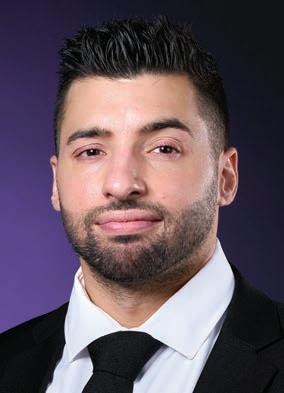
AAC President Omar Kurdi has known Faraj since their time together as students at Cleveland State University.
Empowering fellow Arab American students and professionals alongside his best friend is nothing less than a privilege, Kurdi said.
“Mohammad consistently prioritizes others, never wavering in his commitment to both his career and his community,” Kurdi said. “I admire his dedication, whether he’s pouring his energy into his work at Bitcoin Depot or addressing the pressing needs of our community. He always goes above and beyond. True leaders recognize the weight of their responsibilities, and Mohammad embodies this principle like few others I’ve encountered.”
—Douglas J. Guth



“ e inherent challenge is getting the parties to meet in the middle,” Elder said. “Neither party gets exactly what they want, but it’s about coming to an amicable solution. Sometimes it’s just about getting to ‘OK.’ ”


UB Greensfelder Partner Dolores Garcia met Elder when her current colleague attended CSU.














“My students have gotten past the pick-a-college point, but they still need help navigating that early college space,” said Elder, who attended Ohio State University after graduating from John Marshall High School. “ e challenge is being on this huge campus where you are one of many, while nding a community and a sense of belonging. At John Marshall, my College Now person helped in the decision-making process and nding funding.” Elder said she is far from satised with the success she’s achieved thus far. Whatever comes next in her career, she intends to keep those creative juices owing.
“ e thing about having a law degree is that I can do anything,” Elder said. “In the next 10 years, I can see myself leading this rm in a partner capacity.”






—Douglas J. Guth











Founder, Global Growth Partners
Navarre native Andrew Feucht doesn’t sit still long.
He founded Weston & Associates in 2017 and built it to a 155person company with sales of more than $40 million. e company, which produced specialized storage tanks to hold oil and gas products, foodstu and other materials, as a winner at last year’s Weatherhead 100 awards.
He reluctantly shuttered the company earlier this year due to some supply-chain issues, Feucht said.
“We have a serious issue taking place with an international supplier and it’s put us in a position where we have to shut the company down,” he said.
But, of course, he already has a new company formed and operating.
Feucht said he founded Global Growth Partners and started operating from new o ces in Canton’s Hall of Fame Village on Oct. 1.
Global Growth provides business consulting services, with an emphasis on strategy and sales optimization.
It’s a long way from the big manufacturing rm that Feucht had been running, but in a sense it’s also closer to his original intent when he formed Weston. He wanted to work with oil and gas companies on storage solutions as a consultant and perhaps project manager — but dealing with tank suppliers convinced him he could

pro tably compete with them.
He seems to have hit the ground running with ambitions that aren’t regional or national, but are global.
“I’m ying to Turkey myself in two weeks,” he said. “And I have a lot of (client) companies in Germany.”
Many of his clients were once his competitors, he said.
“One, Tarsco, was my direct competitor and they’re a great company,” he said, referring to another tank company in Missouri, for which he became a business development consultant at the end of September.
e big question might be whether he’s done with manufacturing. Even he’s not sure.
“You have to dedicate your life to it, which I was willing to do and am still willing to do,” he said. “But my passion is in marketing and sales.”
Manufacturing got into his blood when he used to visit his father’s company — also a tank company — as a kid.
But that’s not all he got from his dad, said his friend from childhood, Justin Bergener, who also worked with him as business development o cer at Weston.
Bergener is still in the gas storage business, as director of sales for Arkansas-based Ecomembrane.
As a kid, he knew Feucht’s family well and says he’s a lot like his dad.
“When we were kids, he was working alongside his father through summers and through school. . . .I think that really helped get him where he is today,” Bergener said. “He’s got a lot of determination. He’s always moving forward and he’s very innovative — there’s no obstacle he won’t get past.”
—Dan
Shingler


Director of donor engagement and stewardship, United Way of Greater Cleveland
Life in the nonpro t sector, where donations are a key part of development and operation, can be tough, especially in lean economic times.
Luckily, for the United Way of Greater Cleveland, they have Monica Ghose.
Ghose, the chapter’s director of donor engagement and stewardship, has been with the organization for over a decade, working her way up through a bevy of roles that have given her invaluable experience.
While she says she never saw herself in such a role, she found herself looking for something that involved helping people after graduating from Kent State University. After it was recommended by friends, she did the United Way’s loaned executive program and later passed on an opportunity to work there.
When United Way called back a second time, Ghose said, “I thought to myself, no place calls once, let alone twice, so I should check out that opportunity.”
After several years of working on United Way’s workplace campaigns, she switched to the gifts and giving side and really hit her stride.
“I love knowing that United Way is a pillar in the community, and that the dollars that I helped raise are impacting so many people,” she said. “I think that that coincided with the relationships and connections that I’ve built with donors in the community, that I feel like we are truly making a di erence.”
Her longevity and relationship-building are key to what sets her apart, said Drew Genszler, who worked with Ghose as the former director of legacy and planned giving at United Way.
“She has such a down-to-earth personality and a real heart for people that combines well with a real expertise in her eld,” said Genszler.
He noted that her longevity is unusual in an industry where people can move between organizations with some frequency: “She’s committed to the mission of the organization, which is rare in the fundraising eld.”
And that, he added, is a big plus.
“She puts stock in how she can move both public and private sources of philanthropy into making Cleveland a better place,” he said.





“I enjoy the one on one with donors versus a company,” she said. “Some people are very engaged at the employee kicko s, but major gifts is very di erent, where you have that one-on-one access and you can align goals to move the community forward. I love that.”


Ghose noted the many services United Way o ers — workforce training, food security and their FamilySpace program — to help the community, highlighting the 211 Help Center that residents can call to get information and access to several services. ose services, she said, are at the root of how she’s stuck with United Way for so long, too.

As for her longevity at United Way, Ghose credits her personal growth as well as being able to see the impact of her work.






“It’s wild how much has changed as long as I’ve been here,” she re ected. “But the one constant has always been that people in need is our number one priority.”














We are incredibly fortunate to have Rhonda as part of our team. Since joining the Port in 2012, her hard work, dedication, and strategic vision have made a lasting impact on our organization.












—Marcus Gilmer



























Director of global HR operations, Park Place Technologies
Jonathan Gordon this fall was named director of human resources global operations at Park Place Technologies of May eld Heights, where his role has expanded dramatically in the three years after jumping to the technology concern from Lubrizol Corp. of Wickli e.
He said he was excited to join Park Place because it is a fastgrowing company in information technology, a new eld for him.
However, he had already made a critical shift in his career in his prior job at the specialty chemicals company he had joined in 2013, following working there as a co-op student while getting a chemical engineering degree at the University of Cincinnati.
After working as a process engineer, he shifted to Lubrizol’s HR department to work on its co-op program, after pitching it as a full-time role to expand it globally.
“It became a pipeline for the company to entry level positions,” Gordon said. He also made a fundamental recognition in that role.
“I realized I loved working with people and could make a greater impact in this area,” Gordon said of HR. “I’ve always been good at math and saw working as a chemical engineer to work to make the world a better place. And I realized my background would allow me to work in metrics in human resources.”
At Park Place, Gordon reports to Darlene Engoglia, vice president of global human resources.
“He joined us as a talent acquisitions manager and has taken on extensive responsibilities
It’s no surprise that Andrew Gotlieb entered the building industry, as he followed in the footsteps of his father and grandfather, who were both builders.
Not only did Gotlieb follow in his father’s footsteps, but he gets to work alongside both his parents, Mina and Avner Gotlieb, at Keystate Homes & Development, which the couple started in 1979.
Gotlieb knew he wanted to go into building, but he had more of a passion for residential development, which led him to getting his bachelor of arts in urban geography, city and regional planning from Ohio State University in 2008.
the idea at the time, it “worked out really well, actually.”
“I helped basically reactivate our company,” Gotlieb said. “I tell everyone this. I inherited a lot of integrity from my father, a lot of resources that are nonmonetary.”
Avner Gotlieb’s reputation allowed the door to open for Gotlieb to step in and do what he does now. He’s president of Keystate Homes & Development and president-elect of the Home Builders Association of Greater Cleveland.
raise funds for workforce development.
e group also works with May eld High School to o er a trade program, which it plans to expand to di erent schools.
Aside from his profession, Gotlieb is active with the AntiDefamation League, where he’s a board member. Gotlieb, who is Jewish, said joining was the “best decision” he has made.
while he’s been here,” Engoglia said.
From expanding talent acquisition globally, he has added new areas such as DEI and philanthropy.
Engoglia said Gordon’s engineering background and being a “whiz at Excel” has allowed him to school his reports on the value of data in making decisions, a core Park Place tenet.
“When you ask him to take on something new, his answer is ‘Absolutely.’ And he gets things done,” she said. “He revamped our onboarding process. Last year, he took on a new area, global compensation. He knocked it out of the park. He knows how to roll up his sleeves, as well as delegate.”
e Fair eld, Ohio, native calls Northeast Ohio home, particularly after meeting his wife while working as the church pianist at Hope Ridge United Methodist in Mentor, where she sang.
“Sarah introduced me to musical theater. It opened a new world for me. And our relationship grew from there,” he said.
“We now have a circle of friends we’ve made through musical theater.”
Today, the couple own a home in Painesville and have two young children. ey have performed in local theater productions at Rabbit Run Community Arts Association in Madison, where he is president of the board of directors.
e family holds season tickets to Playhouse Square. Gordon is also an adjudicator for its Dazzle Awards, which recognize young regional talent in musical theater.
After the children are in bed, the two often indulge their love for music. He plays piano while she sings, particularly show tunes.
—Stan Bullard
But because the economy was weak and fewer homes were being built, Gotlieb went back for his master’s degree in urban planning, design and development from Cleveland State University. When he graduated in 2012, Gotlieb told his father they should try to gure out a way to build homes in Cleveland and, although his father laughed at

“Andrew is a tenacious advocate for the housing industry in our community and lobbies for both residents and builder members,” Brenda Callaghan, executive director of the HBA of Greater Cleveland, wrote in an email. She added, “His achievements at work, in the community and the housing industry are both remarkable and inspiring.”
HBA of Greater Cleveland advocates on behalf of the community and builders, educates through training and social activities and — which Gotlieb described as the most important part — does philanthropic work by doing the Make-A-Wish home every year, which helps



“ e amount of hate I think our country is dealing with right now and the amount of hate the Jewish community is dealing with right now, I think it’s even more important to be involved in the ADL and the mission of what it does and it works to accomplish, which is stopping and ghting hate,” Gotlieb said.
When it comes to Gotlieb’s involvement, whether it’s professional or personal, he has pride in everything he does.

“I strive to make my family proud of everything we’re doing and all the hard work we’re doing, all the accomplishments,” Gotlieb said. “... I think they’re really proud of the way that the company is going and the way we’re conducting business, and the homes we build I think speak for themselves.”
—Alexandra Golden







Vice president of business development, Greater Cleveland Sports Commission
Back in 2017, when the Greater Cleveland Sports Commission (GCSC) rst bid on the 2024 Women’s Final Four, the organization’s sta ers were worried about things like, “How do we want to market this and make sure that tickets sell?” and “How do we encourage the market to get involved?”
“I’ll tell you what — the challenges we thought we would have were the opposite of what we ended up having,” laughed Monica Gustin, the executive director of this year’s Women’s Final Four. “It’s better to be lucky than good and I think that for that weekend in April, and the lead-up to it, we were both.
“It was a perfect storm.” is year’s games not only drew sold-out crowds to Rocket Mortgage FieldHouse — and a combined 40.5 million TV viewers for the semi nals and nal — but saw tens of thousands more attend the week’s ancillary events.
For Gustin, who played basketball at Baldwin Wallace University, it was a “dream come true.”
“Women’s sports is so on the rise and to have a very small, individual part of that was incredible, but to see Cleveland shine on that level was beyond ful lling,” she said.
Gustin, a Columbus native, started interning with the GCSC during her junior year at BW and “I drank the (Cleveland) KoolAid,” she said, laughing. She has steadily climbed the GCSC’s ranks, starting as a business development coordinator in 2012 to her current position as vice president of business development, where she manages the organization’s competitive bid




process and development of dozens of large events each year.
“It’s just a holistic, rewarding type of job,” she said. “We’re so mission-focused and you can see the bene t of hosting events and what it brings to the community beyond the economic impact that you see from a study. Just walking around the city when we hosted the Pan-American Masters Games recently, or the Transplant Games of America a few years ago, or the international yo-yo championships, you can see people enjoying your community because of the work that you put into it and that’s so, so rewarding.”
Gustin also is engaged with the community outside of work, having served as a board member of the LGBT Community Center of Greater Cleveland (2019-2021) and having been part of the Cleveland Leadership Center’s Civic Leadership Institute in the fall of 2014. In 2020, she was one of Crain’s Cleveland Business’ Notable LGBTQ Executives and, on Nov. 13, she’ll be honored as one of the 2024 WISE (Women in Sports + Events) Women of Inspiration at the Huntington Convention Center.
“She is immensely talented,” said David Gilbert, president and CEO of the GCSC and Destination Cleveland. “She has the rare ability to see a big picture and vision, but also be able to understand the details to get there — and manage those details. Oftentimes, people are good at one or the other, but she’s really good at both.
“It’s been really fun to watch her grow from being an intern to, 13 or so years later, being an incredible leader. And that’s not just in our own organization; she’s really respected throughout the whole industry.”
—Joe Scalzo






Northeast Ohio outreach supervisor, Help Me Grow Central Intake and Referral
Growing up, Crystal Ann Hall spoke only Spanish, until she entered the Cleveland Metropolitan School District, where she started taking English second-language classes.



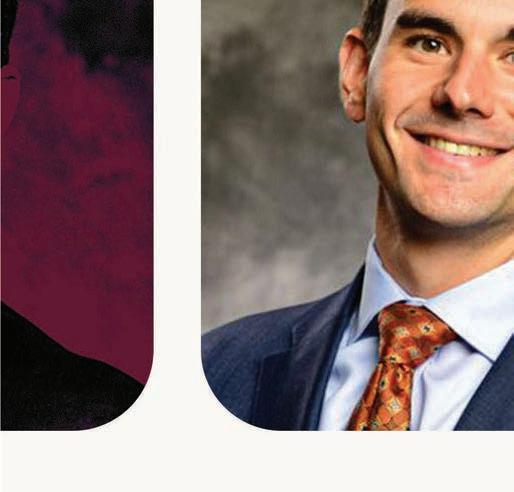
Hall’s grandparents — who adopted and raised her; she refers to them as her parents — are from Puerto Rico, and they spoke only Spanish in the household as they were “very culturally oriented,” she said.
Hall said both of her parents have the “passion to serve the community.” Her dad is a veteran and was the rst Hispanic police o cer in the city of Cleveland’s narcotics tactical unit, and her mom worked within the community.

Hall remembers the rst time she got involved as a bilingual poll worker as a freshman in college.
“I just knew that somehow I wanted to help our community thrive: the Black and Brown community,” Hall said.

the community, they struggled to navigate services in the system. She was “adamant to help change that.”
is mindset stayed with her in her current position as the Northeast Ohio outreach supervisor for Help Me Grow Central Intake and Referral.
“If you want to change the system, if you want to change the outcome, change the statistics, then you have to be part of that system,” she said. “So I felt like maybe taking on the role and being on the other end, where you can provide these resources and these tools to families from the beginning, could eventually probably change the trajectory for that family.”
Help Me Grow has two di erent systems of support, she said. e rst is home visiting and working with pregnant individuals or families from prenatal up until age 3. e other is early intervention for families that have children with developmental delays or disabilities.
wanted to somehow give back to the children in the child welfare system.” She credits most of her passion for serving the community with coming from there, where she worked with marginalized, vulnerable families.
With Help Me Grow, it is “more focused on working with the families from the very beginning” than when they are involved with the juvenile justice system, she said.
Overseeing seven counties in her position, Hall has been able to create relationships with hospitals, community partners and political leaders to share how “important it is for them to be involved.” is June, Help Me Grow and the Cleveland Clinic partnered to host a community baby shower in Lorain County, where more than 100 people came to get supplies and resources.

She saw struggles within the Hispanic population because, although her parents were active in
Prior to working for Help Me Grow, Hall worked for a little more than seven years with the Cuyahoga County juvenile court’s Court Appointed Special Advocate (CASA) program, a volunteer program “for community people who


“She genuinely cares about other people,” said Tricia Kuivinen, executive director of CASA of Cuyahoga County. “She wants other people to be well, to be safe, to be successful, to be engaged. It’s not just about her. So, I think that’s another thing that really radiates out of Crystal, just her genuine love and concern for others.”
—Alexandra Golden



Su He serves as counsel and con dant to individuals and businesses trying to establish a home in the U.S.
According to He, her daily job is helping overseas executives, researchers and other foreign nationals “handle their immigration matters.” Yet, because immigration is one of the rst considerations for foreign direct investors, she often becomes a trusted adviser in a wide range of legal and business challenges.
“Many of these companies, for example Chinese manufacturing companies, know how to do business in their own country, but when they want to invest and start a factory in the U.S., it’s a whole di erent story,” she said. “Even beyond immigration, there’s employment law and the HR practice, so there’s a lot of hand-holding and, sometimes, we become friends, and they share everything from their family di culties, management diculties, so that I can see how I can help them, or my team or my law rm can help them.”
Born and raised in Beijing, He’s rich legal background spans both Chinese and American studies. She graduated from China’s Southwest University of Political Science and Law in 2008 and arrived at Case Western Reserve University School of Law later that year, ultimately nishing her U.S. law degree in 2013.
Immigration wasn’t necessarily on her practice radar, but a summer internship at a Lyndhurst immigration law rm piqued her interest. Soon, He was representing clients on a broad range of immigration issues and options at Robert Brown LLC, Buckley King and her own private practice before her growing case load and client
Kate He ernan did not grow up planning to be a home mortgage broker. However, when she graduated from Ohio State University in 2012, she needed a job and found one at Rocket Mortgage.
Fast forward to today and she runs the Cleveland branch of Liberty Home Mortgage Corp. in Ohio City, a locally owned mortgage company. She feels that part of her would be missing if she left the residential mortgage business.
“Going in, I didn’t know there were two Gs in mortgage,” she said. “Now I feel home ownership is really important. In the last ve years, I’ve seen how owning a home changes people’s lives. I know of three people who would still be renters, but I worked with them to land their mortgage.”
Part of that recognition is because, for years, she has focused on helping people of color or gig workers who drive for Uber who might have trouble documenting their income for lenders.

which may involve more borrower contact and detailed information than other types of loans. In 2023, she closed 98 loans for a total of almost $25 million with loan amounts ranging as high as $2 million. rough October of this year, she has booked 108 units for a total of about $32 million.
major originally thought she wanted to pursue a career in government or politics. She still has the taste for it, though, and canvasses neighborhoods for candidates and serves on the executive committee of the Cuyahoga County Democratic Party, where she votes on its endorsements.
list necessitated the jump to Porter Wright Morris & Arthur LLP, one of the largest immigration teams in Ohio.
“I like the feeling that I can help individuals, even families, to get through their di culties for the rst steps in the U.S.,” He said, recalling the touching moment early in her career when a Middle Eastern client held her hand and thanked her for aiding his son. “ at’s when I said ‘OK, I like this.’ It’s a very rewarding feeling.”
Beyond her legal practice, He is active with the Greater Cleveland Chinese Chamber of Commerce.
As executive director for the chamber’s executive board, she spearheads initiatives to cultivate Northeast Ohio’s global presence, organizing conferences, delegations and collaborative e orts with local and international partners.
“I’m also a board member of the Cleveland Council of World A airs, which helps the Chinese Chamber build a bridge to other international chambers and partners (such as) the city of Cleveland, the mayor’s o ce and Destination Cleveland,” she said.
Anthony Yen, a retired and renowned trade adviser, said Northeast Ohio’s industrial heritage and location make it a strategic region for investments from China and cement He as “a very important person” in international relations.
“Not only is she a good lawyer, but she’s doing this from her heart,” said Yen, who sits on the Greater Cleveland Chinese Chamber of Commerce advisory board.
“She’s putting so much of her personal time into the Chinese Chamber and other people-to-people relationships. Not many people are willing to do that.”
—Judy Stringer
“Anyone can nd a loan for a person with an 800 credit score. Boring,” He ernan said. “I take this approach because it’s a way that I can make a good living and contribute to the community. Don’t believe me? Just look at loan denial rates for people who are Black, Hispanic or female. ey are higher.”
But she prides herself on nding a lender who will take a loan applicant others might not consider,
Khash Sagha , president and owner of Liberty Home Mortgage, said the company has a Cleveland o ce because He ernan lobbied for it to do so.
“It’s not about business strategy for her,” Sagha said. “It’s about community. She’s super-focused. She’s one of our best agents and one of the hardest working people who have worked for me over the last 25 years.”
He ernan lives in an 1880s Italianate Victorian home in Tremont that she is “slowly renovating.” e economics and geography



A self-proclaimed “townie,” she grew up in Kent as her parents continued living there after graduating from Kent State University while pursuing teaching and social work in Cleveland and Akron. In some ways, her desire to help people stems from having a brother, Shawn He ernan, 49, who has Down syndrome.
She also serves as a board member for the Northeast Ohio Worker Center, a worker-led nonpro t that helps people resist unfair labor practices.
—Stan Bullard


Chief operating of cer and regional vice president of Ohio Medicaid, Humana
Numbers have always clicked for Wakita Johnson.
e Akron native excelled in math classes at an early age. When she headed to Ohio State University for undergrad, she planned to study engineering. It wasn’t until she took a social behavioral sciences course that she found her true calling on the business side of health care.
“When I started learning about Medicaid and Medicare ... and how your environment and where you are raised and your access to di erent things impacts your health, that’s what took me over and crossed me over into health care,” Johnson said.
She earned her bachelor’s of science in social behavioral sciences from Ohio State and her master’s of business administration from Franklin University. After graduation, she worked as a proposal writer for UnitedHealthcare. roughout her career, she has held leadership roles at Medical Mutual of Ohio, Boston Medical Center Healthnet Plan, UnitedHealthcare and Blue Cross Blue Shield of Arizona.
She currently serves as chief operating o cer and regional vice president of Ohio Medicaid at Humana Healthy Horizons, a role she has held since 2021. She leads strategic development and
oversees operations for the Ohio Medicaid market.
Johnson enjoys working in managed care, a type of health care delivery that strives to reduce costs while providing highquality care. What drew her to the Humana position, she said, was the chance to serve members in the Ohio market. She was working for a health plan in Boston when the company contacted her about the role.
“I grew up in an underserved, low-income community, and my journey looks a lot di erent than others,” Johnson said. “So to be able to hear and know that the job that I was being recruited for really had that at the core was huge for me.”
John Barger, president of Humana’s Medicaid business, described Johnson as a leader and a di erence maker. Her intelligence combined with her positive energy sets her apart, he said.
“Working through the pandemic in health care can be super, super challenging,” Barger said. “(It) makes a big di erence if someone shows up with a positive attitude, lots of energy, and it’s every single day. When we’re all facing adversity, when she’s facing adversity, the glass is always three quarters full.”
Johnson said her biggest accomplishment has been her impact on members.
“I am bridging access to care with quality of life, but also holistically taking care of the members and community,” she said. “It’s not just about going to see your

doctor. It’s ‘how do we support you in your end-to-end journey to be able to then focus on your health and your care?’ ”
Along with her work at Humana, Johnson serves as a board member at United Cerebral Palsy of Greater Cleveland. She is also co-president of Humana’s Women’s National Resource Group, which focuses on helping women associates grow, lead and nd work-life balance.
Johnson said her career success has come from being comfortable taking up space.
“I think being able to embrace that you’re actually good at what you do and being able to take up space, but the right angle of space, helps me be successful,” she said.
—Paige Bennett
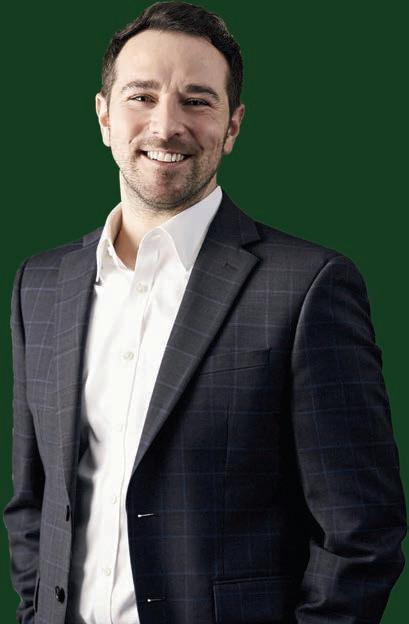
Congratulations to Jason Powers on your recognition among Crain’s 40 Under 40, and thank you for your dedication and leadership.
Director of human resources, Osborn Engineering
Rachele Hill joined Osborn Engineering as its rst human resources-designated employee in 2017 and built the 130-year-old company’s HR department from scratch.
Her successes include implementation of an HRIS System, overhaul of the performance review process, launch of an internship/co-op program and college recruitment plan, creation of an onboarding and orientation program, automation of bene ts administration, formalization of job descriptions and career mapping, and initiation of employee morale and retention e orts.
And she did all of this during a period of explosive growth. Osborn has more than doubled in size from 150 employees when Hill came onboard to more than 330 employees, and it has expanded into multiple states.
“I’m proud of what I built here,” the Parma native said. “I report directly to the C-suite, so there’s not a lot of red tape when I have a new idea or initiative I want to explore. ey’ve really let me do what needs to be done with the department.”
Osborn Engineering President Douglas Lancashire credits Hill with the foresight to know “what a growing company needs.”
“She’s always thinking about our employees and how to best initiate the programs that are required to serve and help manage people,” he said. “We had an orientation program, for example, but she really enhanced it and created a process that our employees, especially our new employees, rave about. When they come to Osborne, it’s a great experience getting introduced to the company and the people.” Hill, who holds a bachelor’s
degree from Muskingum University and an MBA from Baldwin Wallace University, oversees a department with three full-time employees and one part-time intern. Her current passion project is Osborn University, a formal training and career development program for newly hired engineers.
“A lot of graduates can go through a general engineering degree program, but they haven’t worked in the software we use and, much of the time, have not been trained in our speci c AEC (architecture, engineering and construction) techniques,” she said. “ is helps them get o the ground in a more structured and formalized way. ere’s a very signi cant retention component as well — employees needing to receive the training to grow in their careers. Especially the younger generations, they want to see where they can go.”
In addition to her main role, Hill is involved in several Osborn committees. She is chairperson of the health committee, which manages the company wellness program that she overhauled in 2019 to include not only physical health initiatives but mental health, social wellbeing and DEI education as well. Hill also is active in internal philanthropic e orts. In 2023, she led company fundraising events for the American Heart Association walk and helped raise funds for the American Cancer Society, following the loss of two employees to the disease.

Outside the o ce, Hill stays abreast of industry trends by working with the Ohio branch of the American Council of Engineering Companies and attending conferences, and she has presented on HR topics such as wellness programming and intergenerational workplaces.
—Judy Stringer






By Brooke Bilyj for Crain’s Content Studio
As the next generation prepares to enter the workforce, they can learn a lot from the young professionals who paved the path before them.
To spur this cross-generational knowledge transfer, Crain’s Cleveland Business recently hosted a roundtable discussion between ve of this year’s “40 Under 40” professionals and ve bright young students selected by Junior A ievement (JA) of Greater Cleveland.
“We’re trying to ll the gap of recognizing young people in our community,” said JA President and CEO Al DiFranco. “Our hope is to create a yearlong opportunity for these students to get some mentorship.”
In 2025, JA will laun “18 Under 18” to do exactly that; this new recognition program will spotlight our region’s outstanding young people and provide opportunities to build their skills and leadership potential.
In this recent roundtable discussion, Crain’s Content Studio Manager Jennifer Keirn moderated an hour-long conversation that generated insightful advice from experienced executives and thoughtful questions from aspiring young leaders. Highlighting the value of mentorship across the generational divide, the dialogue o ered a glimpse into the evolving dynamics shaping the future workplace.
“[ is event] is a good opportunity for me, for my future,” said Jearen Javier Benitez-Resto, 10, a h grader at Buhrer Dual Language Academy.
The value of mentorship
Recognizing the coa es who guided them, the young professionals were qui to emphasize the value of mentorship in navigating career opportunities.
Chris Kaiser, senior vice president and ief marketing o cer of the Cleveland Cavaliers and Ro et Mortgage Fieldhouse, credited his rst boss for providing the support to succeed — and also the freedom to fail. “He gave me con dence because he allowed me to … make mistakes,” he said. “Find someone who believes in you and will give you opportunities — but then you also have to take them.”
Students a nowledged their parents or tea ers as mentors, then asked for advice on expanding their networks. “You make connections in lots of di erent ways,” explained Claire Bank, an ar itect at enDesign Ar itecture — whether through sports, volunteer organizations or professional work.
“Networking and [building] connections will take you a long way,” agreed Monica Ghose, director of donor engagement and stewardship at United Way of Greater Cleveland. “All of those connections can help in the long run, so talk to everybody with respect. You never know when you’ll cross paths again.”
Professional development
With dream jobs ranging from investment banking to international business, the students asked the young professionals what type of experiences can set them up for success and help them nd their passion along the way.


40 UNDER 40 HONOREES
Adam Artman, President and Executive Director, Manufacturing Works
Claire Bank, Educational Design Lead, ThenDesign Architecture
Monica Ghose, Director of Donor Engagement and Stewardship, United Way of Greater Cleveland
Rachele Hill, Director of Human Resources, Osborn Engineering
Chris Kaiser, Senior Vice President and Chief Marketing Of cer, Cleveland Cavaliers and Rocket Mortgage Fieldhouse
JUNIOR ACHIEVEMENT STUDENTS
Jearen Javier Benitez-Resto, Buhrer Dual Language Academy
Cooper Bottcher, Chagrin Falls High School
Jaivon Hall, Garrett Morgan School of Leadership and Innovation
Nora Klein, May eld High School
Rose Lane, North Olmsted High School and Polaris Career Center
Ra ele Hill, director of human resources at Osborn Engineering, recommended internships. “Even if it’s unpaid while you’re in high s ool, it’s going to help you navigate what you want to do,” said Hill, who pursued a mortgage banking internship and explored social work before earning her business degree. “ e more stu you try out, the more you can gure out what you actually want to do.”

And, just as importantly, “you’re going to learn [what] you don’t want to do,” added Kaiser, who initially studied accounting and started his career at PwC before pivoting into sports marketing, emphasizing the importance of “being open to new opportunities.”
Others reiterated this advice throughout the conversation, e oed by Adam Artman’s “just say yes” philosophy. “Everything’s a learning experience,” said Artman, president and executive director of Manufacturing Works. “What separates people from nding their ceiling early, versus nding their ceiling later, is their ability to learn.”
The Gen Z vibe
To harness the vibes that Gen Z brings to the workforce, it’s vital to understand the value they add. ese strengths include “knowing what we want in our work environment and communicating our needs,” said Jaivon Hall, 17, a student at Garrett Morgan S ool of Leadership and Innovation.
“My generation, a lot of them are passionate about what they’re into and they take the lead,” added Cooper Bott er, 18, a student at Chagrin Falls High S ool.
at ambition comes with expectations, thanks to social media. Having grown up wat ing YouTubers and TikTok stars broadcast their luxurious lifestyles, “We’re surrounded by the idea of money and success, so there’s a lot of pressure on young people,” noted Nora Klein, soon-to-be 18, a student at May eld High S ool and an intern at JA.

“We’re all in a rush to get a job, make money, start a family. … We’re trying to get ahead.” is accelerated drive to succeed, combined with the boldness to ask for what they want, will propel this generation forward — especially if they lean on the support of those who have gone before. “Be receptive to the coa ing they’re trying to o er you,” Hill advised.
By facilitating dialogue across the age gap, this conversation proved that leaders have plenty to learn from Gen Z — not just the other way around. By exing their unique perspectives, Gen Z is poised for the future ahead.
“[Because of] the opportunities we’re being given now, we’re learning so mu younger,” said Rose Lane, 17, a student at North Olmsted High S ool who also attends Polaris Career Center. “We’re already ahead of some college students, and we haven’t even graduated high s ool yet.”
Learn more
To learn more about Junior A ievement’s upcoming “18 Under 18” initiative or its other work in Greater Cleveland, visit www. jacleveland.org or contact JA President and CEO Al DiFranco at adifranco@jacleveland.org or 440-339-1974.






Executive vice president and chief marketing of cer, Cleveland Cavaliers
Chris Kaiser likes to say that if you’ve known him for more than an hour, you also know he’s from Buffalo, “because I bring it up.”
He sees the same civic pride in Clevelanders, which is great if you sell Ten Cent Beer Night T-shirts or work as, say, the chief marketing officer of the Cavaliers.

“I’ve lived in places like Orlando and Scottsdale (Arizona) and there are so many transplants — and there’s less personality to the city,” said Kaiser, who served as the director of marketing and brand strategy for the Phoenix Suns before the Cavs hired him in 2018. “Cleveland just has a unique feel. People are proud of people who are from here and people boomerang back here from bigger cities. That makes my job pretty easy because people are so into the sports team.”
rookie season (2021-22), helping the Cavs string together some wins, “and I was like, ‘Holy (bleep), we’re sold out for the next two months!’ ” Kaiser said. “That wasn’t a Phoenix thing. We were selling more to the opponents’ fans than the Suns’ fans.”
The Cavs still sell lots of tickets — they’ve sold out their last 95 regular season home games — but Kaiser has played a huge role in everything from the Cavs’ Center Court team shop transformation to their NBA City Edition collection to their social media strategy (which is currently the fourth highest in the NBA) to their activations in Brazil (which won the team an NBA International Strategy award) to their wildly successful Kelce Bobblehead Night on March 5, a game that saw the Cavs overcome a 22-point deficit to beat the Celtics in front of Northeast Ohio natives Jason and Travis Kelce.
podcast blew up. Jason Kelce retired the day before the game and we came back from 22 down to beat the Celtics and they were on the sidelines getting everyone going. So it was just a perfect mix. That was one of the few times (Cavs CEO) Nic (Barlage) called me at night and said, ‘That was a 10 out of 10, brother. An absolute 10 out of 10.’ ”
While Kaiser has always had an affinity for numbers, he loves combining data and analytics with the creative side of the business. And by working across departments, he does a very Rust Belt-esque job — he builds bridges.
Case in point: Cleveland forward Evan Mobley had a good stretch of games early in his

“I always say marketing is timing and luck and sometimes you can look like a genius,” Kaiser said of the Kelce game. “We started that before (Travis) was dating Taylor Swift. Then their
“Chris is a relationship-first leader,” Barlage said. “His commitment to both the professional and personal development of our team members has established a vibrant culture of camaraderie and collaboration within our marketing team, as well as across the business. His unique ability to blend analytical and creative thinking continuously drives our business forward and positions our enterprise for future growth.”
—Joe Scalzo


Founder and CEO, Babylon Asset Management
Hanna Kassis long dreamed of becoming an entrepreneur, even if he wasn’t always quite sure how he would get there.
Kassis was brought up in the Youngstown area by immigrant parents who came to Ohio from Palestine.
His mother, Brenda Kassis, works as a medical administrative assistant. His father, Mousa Kassis, had family in the area working in steel mills, though he initially found work in grocery stores here in the U.S. — which was all before purchasing his own grocery and later joining Youngstown State University as an economics professor.
“I was brought up in a culture where I saw how hard everyone worked, including as business owners, and how much they sacri ced for us,” Kassis said. “So, I needed to be an entrepreneur. I just felt like I had to do more than get a desk job. And I mean no disrespect by that. But I always wanted to carve my own path. And I never wanted the pain or su ering of a lost job.”
Kassis studied accounting in college and later moved to Chicago to earn his law degree. ere, he launched his rst business, Oarex Capital Markets, an online ad revenue exchange where digital media companies sell invoices for capital.
ose early days in the mid2010s were tough. Oarex was just getting going, and Kassis didn’t have any steady income. He made ends meet by designing websites and running up credit cards.
ere was a time when Kassis was living on $10 a day, which covered a daily can of sardines and whatever the beer and dinner special was at his local dive bar that night.
Partner, Benesch Friedlander Coplan & Aronoff
Born in Ukraine and speaking only Russian, Yelena Katz immigrated to the U.S. at the age of 7 with her mother and grandmother. e family had “no money and no connections,” Katz said, when they settled in Cleveland to be near extended relatives.
“It was a lot coming from a very di erent culture, a di erent language,” she said. “My oldest son is about to be 7, and I can’t imagine what it would be like for him to move to a di erent country and start over. But I’m so grateful every day that my family made the choice to move here.”
e May eld High School graduate made the most of it, securing a spot at Case Western Reserve University and earning a bachelor’s degree in three-and-a-half years before beginning law school, also at CWRU.
Kassis caught a break when he secured $25,000 in startup capital for Oarex from Bizdom, the former business accelerator backed by Dan Gilbert.
“ at was a pivotal moment in my life, when Dan Gilbert put me in business,” Kassis said.
In 2022, Kassis sold the bulk of that business and applied some of the proceeds into standing up his new private credit fund, Babylon Asset Management.
He also bought the Whistle & Keg pour-your-own-beer taproom in downtown Cleveland (now the Whistle Taproom & Venue).
Kassis is securing investments in the multi-millions for his credit fund, which has participated in about 170 deals since summer 2022.
Lee Zapis, president of Zapis Capital Group in Westlake, has been following Kassis’ career since meeting him at one of those Bizdom pitch competitions. He didn’t invest in Kassis then — “my mistake,” Zapis said — but he’s been supporting him as a mentor ever since.
Zapis describes Kassis as “driven, motivated and very enterprising,” adding that he “understands the hard work and sacri ces it takes to be successful.”
“He’s had a very unique and interesting career so far and has made his mark on Cleveland in more ways than one,” Zapis said.
Kassis aspires to start another direct-funding company and to become less and less reliant on investor support, but he’s in no rush to get there.
“One thing I’ve learned is when you’re making a tough decision, give yourself time. Don’t make that decision if you’re on the fence about it,” Kassis said. “I’m always trying to be more thoughtful in slowing down my decisionmaking process.”
—Jeremy Nobile
tions and workplace culture, hiring and discipline, health and safety, and labor relations. She also represents clients before government agencies, arbitrators and courts nationwide and counsels them regarding employment issues in multimillion-dollar business transactions.
“I really love working with the businesses and helping them really manage their best asset, which is their people,” she said. “Most businesses can’t succeed in the long run without having a good relationship with their employees. Part of my job is to help employers make decisions that allow them to hire and retain talented people and institute compliant policies to manage their relationship with their workforce.”
Margo Wolf O’Donnell, cochair of Benesch’s labor and employment division, called Katz a “model for other attorneys,” citing her colleague’s diligence, responsibility and thoughtfulness.

necting Benesch women attorneys and female clients — to other o ces.
After law school, Katz joined Jones Day in 2014, where she “dabbled in di erent practices” as a rst-year associate and ultimately landed in labor and employment. She continued the practice after a lateral transition to Benesch in 2019. e rm named her partner in January 2023.
At Benesch, Katz provides comprehensive advice to business executives, human resources professionals and in-house counsel that includes compliance with employment laws, employee rela-
“We’ve been involved in contentious litigation, and Yelena is poised and thorough. Her writing and oral advocacy skills are both very strong,” Wolf O’Donnell said, adding that the highest praise comes in the form of “our clients having complete con dence in Yelena.”
A strong advocate for diversity and inclusion, Katz vice-chairs Benesch’s Women’s Initiative, spearheading its B-Sharp initiative in Cleveland and rolling out the program — which aims to facilitate external networks by con-
“It gives everyone an opportunity to get to know each other, to learn new things that are happening in the law or to bounce ideas o each other for other issues,” she said. “Our women attorneys also get to know clients from different practice groups and potentially expand their practice, as well.”
O the clock, Katz is an active board member of the Valley Art Center, a nonpro t in Chagrin Falls, where she heads up the governance committee, and a barrister with the Cleveland Employment American Inn of Court.
—Judy Stringer

Founder, executive director, Breadwinners Academy
When Carmen Daniel first approached Jason Lockett Sr. in 2021 about teaching money management to a group of Cleveland Heights High School students, his answer was: “Absolutely not.”
“I didn’t think they were going to listen, and I didn’t see myself as an educator of any sort,” said Lockett, a certified financial planner. “But after talking more with Dr. Daniel, I decided to give it a try. I went into the classroom and had an amazing time with the students.”
One lesson turned into multiple sessions, and, in 2022, Lockett launched the nonprofit Breadwinners Academy, which today teaches financial literacy and entrepreneurship in 15 schools across Northeast Ohio. To date, he said, the academy has instructed more than 400 individuals, led to the opening of 85 youth bank accounts and 68 youth brokerage accounts, and assisted with the creation of 15 student businesses.
Lockett’s especially proud of the impact, given that many of Breadwinners Academy’s students live in financially distressed households.
“When you come from these communities, you’re not thinking about building wealth. You’re thinking about your immediate needs, and that mindset negates the ability to save and invest,” he said. “That’s a huge challenge.”
Along with reversing this “poverty mindset,” Lockett said another big impetus behind starting Breadwinners Academy was helping teens and young adults avoid the money missteps of his youth. He admits “making bad decisions” during his years as a marketing student at Notre Dame College.
To overcome his “poor financial past,” Lockett began teaching himself about credit, investing and wealth-building in the years following graduation. He went on to earn an MBA in finance from Ashland University and a certificate in financial planning from Howard University. Lockett opened a financial consulting business, called The Breadwinners, in 2015.
While he still operates the consultancy, Lockett estimates that 80% of his time is spent with the academy. In addition to serving as an instructor, he oversees seven others who go into schools with the nonprofit’s financial curriculum.
This year, Breadwinners also launched its summer program, a six-week course in which 25 Cleveland high schoolers were bussed to John Carroll University to learn the ins and outs of budgeting, banking, investing, credit, college admissions and aid, insurance, taxes and more.
“At the end of it, each student earned $2,500 that they can use towards college or expenses, and I think we gave away a little over $55,000 for the program,” he said. “It was definitely an amazing experience. ... We plan to expand to three locations next summer, adding programs at Case (Western Reserve University) and Cleveland State (University).”
Daniel, who is an engagement specialist with Heights Career Tech Consortium and director of education for Breadwinners Academy, said authenticity is Lockett’s secret sauce.
“I don’t think he’s trying to be a teacher. I don’t think he’s trying to be a philosopher,” Daniel said. “He just truly wants our minority students to have generational wealth and not be stuck in that poverty mindset, and that authenticity really connects with the students.”
—Judy Stringer


Executive vice president, Starting Point
Early on, Kara Porter knew she wanted to help others. But after having a child, she needed some help herself.
Porter remembers being a new mom — and being shocked by how expensive child care was.
“Child care is this super personal thing for families,” Porter said. “It’s your kid getting the right start in life while you’re still progressing in your career. I wouldn’t be where I am today if I hadn’t had the support through the child care programs that my kids went to. At certain times, I was balancing what could I a ord to do for child care and make sure that I was staying in the workforce.”
Now, as executive vice president of Starting Point, Porter is helping other working parents navigate the same dynamics and nd quality child care, preschool and afterschool activities.
“It’s just wonderful to be able to work on such an important issue that lays the foundation for a child’s whole life,” Porter said.
Porter helped establish Starting Point’s collaboration with the city of Cleveland’s scholarship program. Since the city began o ering scholarships for childcare in May 2023, an estimated $2.1 million has been distributed to over 360 families to help working parents be able to a ord child care so they can stay in the workforce.
Prior to joining Starting Point, Porter spent about eight years at the United Way of Greater Cleveland, directing, managing and monitoring multimillion-dollar investments in health and human service programs in early childhood education, youth de-
velopment and workforce readiness.
at’s where Porter met Nancy Mendez, then the vice president of community investment at United Way, where they worked on several projects together. Porter’s commitment to the community and passion are a few of the reasons why Mendez sought her out shortly after being con rmed as the president and CEO of Starting Point.
“I told Kara, if I take this job, you’re coming with me, and we’re doing this together,” Mendez said. “She laughed, but my rst, most important, and best decision was to call her. You’re not going to nd a more authentic, genuine, passionate human being who truly just wants to make her community a better place for everyone to live in with a super focus on children. Her heart, her passion, has always been ‘I want every child to be able to have an opportunity to succeed, regardless of their ethnicity, their race, their ZIP Code.’”
Outside of Starting Point, Porter serves on the advisory committee of the atcher Family Fund at the Cleveland Foundation. She also is a board member for the Lakewood Rangers Education Foundation, an organization that raises funds for the Lakewood schools, where her children attend.

“I just feel so lucky to be here, raising my kids with my husband,” Porter said. “I love Lakewood, I love Greater Cleveland, and I’m super passionate about tackling some of the big challenges. I’ve always tried to work for organizations that are directly serving people. at’s the work that I want to continue to do, to make sure that the systems are working for people, instead of against them.”
—Nicole Stempak


Partner, Brennan Manna Diamond
Bryan Meek has developed a reputation inside the courtroom — and on YouTube.
“ e law is complex and nuanced, but there isn’t a reason why lawyers can’t make it approachable and easy to understand,” Meek said.
Meek is a partner at Brennan Manna Diamond and co-chair of the rm’s employment and labor law group. Meek has been with the rm for about a decade, starting as a law clerk while a student at the University of Akron School of Law.
“Bryan was one of the youngest attorneys to become partner,” said Amanda Waesch, vice president of BMD. “ at is due to his unparalleled work ethic, his knowledge as an employment lawyer and the fact that he has a national practice.”
During COVID-19, health and safety guidance was frequently changing, and Meek needed to help his clients stay informed. at sparked the idea for Employment Law After Hours, which now boasts over 1,400 subscribers on YouTube Podcast. Meek has hosted and produced over 50 episodes. He says a lot of those early episodes were focused primarily on COVID, but evolved into employment issues in general.
“It’s just this new way of marketing — even for an old profession like law — and it’s really targeting millennial leaders and future Gen Z leaders by reaching them where

they’re getting their content,” Meek said.
e podcast is meant to be educational, informative and fun for people to sit and watch — not dry discussions of legal matters that would put people to sleep. In fact, it was one of the rst things his now ancée mentioned when Meek rst met her family.
“Next thing I know, her parents are putting on this YouTube channel for the whole room to watch,” Meek said with a laugh, adding that his clients frequently mention his podcast, too. “ ey’re like, ‘Hey, I caught your video. It was great information. at’s why I wanted to give you a call. I have a question about that issue, too.’”
Meek notes that podcasts do not constitute legal advice and that any online engagement does not create an attorney-client relationship, but it has led to new clients and an increase in revenue, both for him and the rm.
Waesch said that Employment Law After Hours has been a tremendous, creative success, and that Meek’s entrepreneurial initiative is an embodiment of the rm’s values.
“Bryan is a tremendous attorney,” said Waesch, who supervised Meek as a law clerk and afterward extended him a job o er on behalf of the rm. “He’s just an amazing individual. His focus on helping clients is second to none. He also cares very deeply about the people he works with and the law rm itself. We’re very grateful he’s part of the rm. He’s just getting started, and we’re excited for him.”
In addition to his client work, Meek also does pro bono work for the Legal Aid Society. He also serves on the board of Tuesday Musical, a Summit County-based musical arts nonpro t, and the St. Vincent-St. Mary High School Foundation.
—Nicole Stempak








Deputy chief of staff and chief of government affairs, City of Cleveland
As a campaign veteran, Ryan Puente is comfortable with the hectic final weeks in the run-up to an election.
“I don’t know if it’s the chaos, the not-nine-to-five of it or the always-on of a campaign, but I thrive in it,” Puente said.
At 34, Puente, who serves as Mayor Justin Bibb’s deputy chief of staff and chief of government affairs, is an experienced campaign leader, political operative and a fan of running for and then helping run Cleveland’s City Hall.
“It turns out there are a lot of similarities between campaigns and in-office work — it is just a never-ending campaign,” he said. “You are always juggling 15 different balls at one time, and there’s just as much politics inside as there is out.”
Puente began his focus on public service and constituent work with two stints interning in U.S. Sen. Sherrod Brown’s office during and after his time at Ohio University. He followed that up with a prestigious internship at the Obama White House while getting his master’s degree in D.C.
Those three unpaid internships also provided a less formal set of experiences. Commuting to a job without a car and working a night shift, while also being a full-time George Mason University student, helped solidify that the work he did with constituents was important.
He also learned that even with a master’s and the White House on your resume, you might end up working as a union bricklayer in Cleveland.
“I was pretty homesick, so I moved back the day after graduation, and when I moved back, I
Senior vice president, CDC advancement and resilience, Cleveland Neighborhood Progress
As an undergraduate business major at Indiana University’s Kelley School of Business, Jason Powers was focused on traditional disciplines — finance, accounting, marketing.
But it was a different track of his studies, in economic and public policy, that changed his career trajectory, and now, in his role at Cleveland Neighborhood Progress, could bring big changes to Cleveland’s community development landscape.
needed to just start working,” Puente said.
His short career in the trades ended after Brown’s longtime state director, John Ryan, recommended Puente for a policy and campaign research position at Burges & Burges.
Ryan, who knew Puente from his work helping constituents in the senator’s office, was quick to vouch for his passion for public service and ability to think strategically.
“He was different than anyone else I’ve ever helped. As an intern, he just called me up and asked point blank if I would mentor him. No one had ever asked me that before,” Ryan said. “He took notes. He followed up. He was super-serious, and he has the talent to absorb a massive amount of knowledge.”
Aside from his work at Burges, Puente resurrected the then-dormant Cuyahoga County Young Democrats and got reacquainted with the community as part of the Neighborhood Leadership Institute.
After running a handful of ballot and school campaigns, the just barely 30-year-old Puente was approached by an up-andcoming civic leader and asked to head up a long-shot campaign to become Cleveland mayor.
Currently, Puente is focused on re-establishing Cleveland as a national presence, and the dogged pursuit of state and federal grants to fund Clevelandbased infrastructure and development projects.
When he is not on the phone with various local or Washington contacts, he tries to unwind outdoors with Amanda Puente, his high school girlfriend (now wife), and dog, Lola.
And whether it’s election season or not, Puente appreciates whatever down time he gets.
—Kim Palmer
Powers’ career has taken him to Washington, D.C., where he worked for a member of Congress from Massachusetts and said he became interested primarily in the “power and impact in communities that comes from the federal system,” and then, well, traveling a lot of the country in roles at NeighborWorks America, a trainer of community development, financial capability and affordable housing professionals.
Those jobs were satisfying and suited his public policy and advocacy interests. But Powers, who grew up in Beachwood, said he “started to get an itch” to return to the Cleveland area to make a difference close to home.
He did that by getting hired in September 2014 at the Old Brooklyn Community Development Corporation, as director of development and marketing at the CDC.
“It was living the work of community development,” said Powers, who bought a home in the neighborhood, too.
Powers said he loves the Cleveland area, despite its challenges, because the city and its metro area are “active and engaged. ... We live in a place where people have to get involved, and they do.”
He moved in the spring of 2019 to a job with the city of Cleveland as director of the Middle Neighborhoods Initiative, an effort aimed at bolstering neighborhoods, while also attracting and


retaining middle-income residents often lost to surrounding suburbs. Then, a little more than two-and-a-half years ago, Powers returned to his CDC roots by taking a job with the nonprofit Cleveland Neighborhood Progress, as senior vice president of CDC advancement and resilience.
That’s a long title, befitting a long-term change Cleveland Neighborhood Progress is trying to foster.
Cleveland Neighborhood Progress in the spring rolled out a new system for assessing and funding CDCs in Cleveland, with the goal of providing assistance that’s more tailored to each organization’s strengths — as well as its weaknesses.
It’s a wide-ranging effort. The nomination noted that Powers “built a team of relationship managers who each provide personalized coaching and development for CDCs.” He also “worked with the entire CDC network, industry leaders and government officials to establish the CDC Assessment Model, a comprehensive way to evaluate the capacity of these organizations across five common areas.” Finally, he launched the Advancement & Resilience Initiative, a “responsive and trust-based grant making program to meet each CDC’s needs.”
The general idea, Powers said, is to focus on creating CDCs that be-
come stronger by being better able to handle the basics of community development. Rather than “saying yes to everything,” which creates inefficient organizations, the goal is to help CDCs “become excellent at the targeted things they can do to make their communities stronger.”
Emily Yahr, a high school friend of Powers who now is a reporter at The Washington Post, said she’s not surprised by Powers’ commitment to community development issues — or by his choice to do it in Cleveland.
“I don’t know that I’ve ever met someone as passionate as Jason,” Yahr said. In D.C., she said, he felt strongly about building up communities and talked about his hometown frequently. “Everybody he met could tell you facts about Cleveland,” she said. And in both work and social settings, she said, Powers is a “convener” who “wants to make sure everyone is included.”
Powers is on the board of the Hebrew Free Loan Association, an organization that provides interest-free loans to Northeast Ohioans unable to access safe and fair lending resources. He’s an avid gardener and a musician who plays cello, piano and guitar. But being home keeps him busy these days, too, as Powers and his wife have a 1-year-old son.
—Scott Suttell
Chief of communications and strategy, Cuyahoga County
For nearly two years, David Razum, as a deputy chief of staff in the Cuyahoga County executive’s office, has overseen the more than 4,500 employees who work for the 1.2 million residents living in the 57 cities and two townships that make up the county.
In his position as one of the four deputy chiefs who report directly to County Executive Chris Ronayne’s chief of staff, nearly every policy program and legislative initiative at
one point comes across his desk.
“What is unique about our model is that in my role as deputy chief of staff for communications and strategy, I share oversight with three other deputy chiefs and the county’s departments report up to us,” Razum said.
The model helps break down silos because, he said, “you need different departments, different people in order to tackle the large problems. This structure gives us the flexibility to do that.”
Tackling the big problems is a priority for Ronayne, the county’s third executive, and the man who Razum worked to get elected.
The two met when Ronayne ran
engagement manager, open Doors Academy
Coming from a family of educators, Daa’iyah Rahman never saw herself as a teacher, but she always wanted to engage with and support families in the community.
In 2020, she dove in headfirst, joining Open Doors Academy (ODA) as a program coordinator, working on the front lines as the educational nonprofit shifted its out-of- school programming to support the virtual learning environment during the pandemic.
She guided nine first grade scholars through school online, going above and beyond to help keep the students engaged.
“It required mentorship, just being able to advocate for them for something as simple as headphones,” said Rahman, who scoured Five Below for character headphones that would hold the children’s interest. “Half the class had Mickey Mouse, and the other had Blue’s Clues, but they were so excited to be in the room and be on their lesson, just because of a small incentive.”
In the four years that Rahman has been with ODA, she has held a new role each year, giving her hands-on experience across
the various components of its work. After supporting the scholars, Rahman worked with parents as a family advocate to provide community resources.
She then transitioned to the advancement team. This work took her out into the community to speak to partners, donors, board members and families to build awareness about the organization’s work.
“I think she can speak with a real authenticity about the work, because she’s run programs, she’s been on the family team, she’s had conversations with scholars, with families,” said Joe Hollings, director of engagement at ODA.
Rahman knows every kid and donor’s name, which helps make them feel comfortable and build relationships, Hollings said.
“It sounds small, but I mean, it’s important that people get your name right,” Hollings said. “And Daa’iyah, not only does she know (their names), but she knows their stories. And people are drawn to her because of her personality.”
Rahman has been instrumental, Hollings said, in creating an intentional strategy in how the organization engages volunteers and works with corporate partners.
She has also worked on media
outreach and helped get scholars featured on WKYC.
“Especially as a woman of color, I often face imposter syndrome,” Rahman said. “So to be able to confidently, always come to the table and know that my voice is going to be heard — that’s not something that I ever questioned — but that’s contributed to my work and helping to create the culture at the office.”
This year, she was promoted to engagement manager, which combines her communication and relationship-building skills with her passion for storytelling and community activism. In this role, she aims to equip the community with access to meaningful opportunities and to champion equitable funding for local initiatives that directly impact education and the arts. But it goes beyond funding.
“A lot of times, people think monetarily … but there’s so many ways that you can give outside of giving your funds,” Rahman said. “Being able to highlight that is what I’m looking forward to — the activism portion of my role — but also the innate responsibility that philanthropists have in serving the community.”
—Lydia Coutré

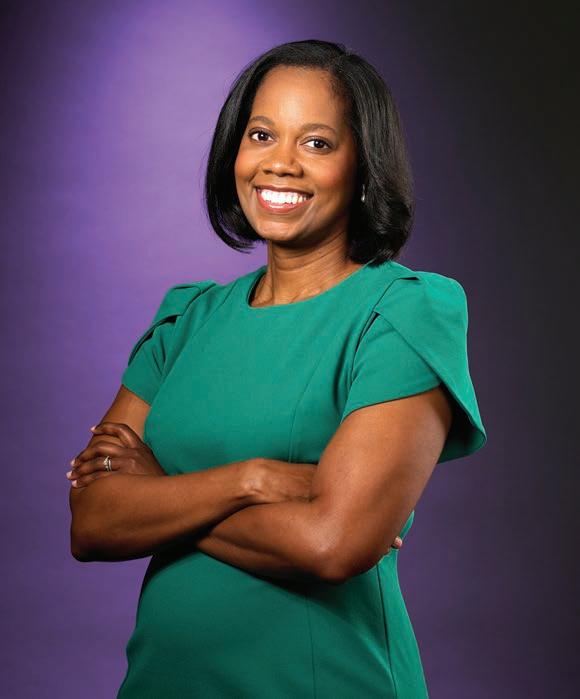
In summer 2022, LaVonne E. Pulliam and her husband answered the call to return to Cleveland.
They had been living in Minneapolis for about six years, but the murder of George Floyd and the unrest that followed deeply affected Pulliam’s family. They had been thinking about how best to make an impact in their community and about moving closer to relatives.
“We both got our offers within a week of each other, and we took that as God telling us that Cleveland was where we needed to be,” Pulliam said.
Pulliam grew up in Columbus, but came to Cleveland to study at Case Western Reserve University, where she earned her bachelor’s in biology, a master’s in bioethics and a juris doctorate.
Recently, she helped to develop UH’s policy on artificial intelligence (AI), as well as the establishment of a governance committee to oversee its usage. And, for the 12th time, she helped UH secure a spot as one of Ethisphere’s World’s Most Ethical Companies.
University Circle Inc. (UCI) and Razum led communications for the organization.
“We ran a long and hard campaign,” Razum said. “For me, that year was formative. I learned a lot about what people want to see from their county government. And then working on the transition team, I brought that year’s worth of conversations with me.”
Running a successful campaign and then working in that administration was not always Razum’s dream career path.
“I do come from a family of public servants, so I’ve always been interested in the systems that work to make a difference in the com-
munity,” Razun said. “And I’ve always been engaged on some level in local political activity and attracted to organizations trying to make a big impact in the region.”
Razum is a natural at tackling complex problems, said Greater Cleveland Partnership’s Marty McGann.
“His work ethic and humility make him a natural leader,” said McGann, GCP’s general counsel and executive vice president of advocacy and strategy. “He is just a smart strategist and someone who truly cares about the people he works for, and is always willing to take a collaborative approach.”
McGann meets with Razum
weekly to talk about how both government and business leaders can best advocate for the region and rework the way the county pursues the unprecedented level of competitive state and federal grants funding available.
The county with Razum at the helm has been able to bring in millions for large solar installations and renovating the Veterans Memorial Bridge.
“He is a great guy and a great person to work with and we need to have people like him in these important roles to ensure that we, as a region, can get this critical development work done,” McGann said.
—Kim Palmer
Pulliam is the chief compliance officer for University Hospitals (UH), where she oversees the health system’s compliance, ethics and privacy program, as well as its training program. She is responsible for ensuring UH adheres to internal policies, as well as external legal and regulatory requirements.
“In the course of my week, I can go from speaking to a board member to talking to a physician to engaging with a leader to working with a patient, and I can really interact with all of the individuals who are part of — and are integral to — our health system,” Pulliam said. “I am someone who believes in and loves community, so (my role at UH) helps me make sure I feel like I’m a part of the community that we work in.”
Through her words and deeds, Pulliam is helping UH develop a safer work culture.
“LaVonne and her team are really focused on working in a multidisciplinary environment along with legal, human resources, finance, quality and clinical leadership,” says Harlin Adelman, chief legal officer at UH. “It’s not about using somebody to set an example. It’s about understanding the root cause, what led to this behavior and how can we positively address this. What’s really innovative about her leadership in this space is that there isn’t this sense of ‘compliance is breathing down on us.’ There’s a real sense of, ‘I’m glad compliance is involved, because we do have to address a cultural issue, and this is the right team to come in and do it.’”
Outside of work, Pulliam serves on the board of the YWCA of Greater Cleveland and volunteers with the Greater Cleveland Food Bank.
While Pulliam is looking forward to reaching new milestones, she also is looking for ways to support the next crop of compliance professionals and individuals of color as they navigate their career paths.
“I want to make sure that I’m mentoring and growing the next set of leaders who I think are going to be necessary to move us into the next evolution of our society,” she said. “I didn’t get to where I was without a lot of help and a lot of support from people along the way, including my family, close friends and mentors. I want I want to be able to do that for others.”
—Nicole Stempak
e same drive that pushed Angel Rice to excel on the court or eld as an athlete is now fueling her success in the accounting profession.
Rice is a relatively new partner at Cohen & Co., but she has made quite an impact during her 14 years at the rm so far, especially for someone who hadn ‘t always considered this career path.
Rice was originally a biology major in college and was considering charting a path to becoming a doctor. Math and numbers always made a bit more sense to her than organic chemistry, however. She changed majors to focus on nance.
“Looking back, I don’t think I could be dealing with the general public and the medical profession,” Rice said. “ at ‘s just not how I’m built.”
Active in basketball and softball through high school and her tenure at Case Western Reserve University, Rice did once envision herself as a sideline sports reporter. But accounting seemed like a more practical choice, and she hasn’t looked back since.
“In tax itself, there is a lot of gray area. But in accounting, in general, it adds up or it doesn ‘t,” Rice said. “ e ways of debits and credits and all that has always come easy to me. It ‘s what clicks for me.”
Rice, who works primarily in the real estate practice, created a new service focused on quali ed opportunity zones that, by proxy, has helped spur economic development and job creation in low-income communities since 2017 — well before she made partner.
“ at was an opportunity where you ‘re on a level playing eld with other partners, and
you don ‘t really get a lot of opportunities to equal with them, so to speak,” Rice said. at has since grown into an annual $3 million practice.
Rice also strives to mentor others and pay forward the support that she says has helped her. Some of the boards or associations that she ‘s involved with include the National Association for Industrial and O ce Parks (NAIOP) Northern Ohio Women’s Leadership Network — which she helped create — and the CWRU Spartan Club.
Dave Sobochan, a tax partner and market leader for Cohen’s real estate and construction practice who has worked with Rice throughout her 14 years at the rm, describes Rice as “fearlessly competitive” but respectful, someone with an “old-school work ethic.”
He said he’s been impressed by the way she carries herself with an “executive presence” for someone relatively early in their career. Rice sets a “blueprint for all of our younger team members, which is that you can become a rm expert in a new program if you have the drive.”
“She has had an immeasurable impact on our rm due to her leadership and mentorship, as well as the countless hours she spends by donating her time to NAIOP,” he said. “Her e orts will be felt by the region for years to come.”

Supporting others, whether those are clients, colleagues, mentees or teammates, is just as important as excelling in a career itself, Rice said, adding that she preaches giving as much or more to someone as you might ask of them.
“You ‘ve got to put your deposits in with people before making a withdrawal,” she said.
—Jeremy Nobile


When Michael Repasky joined Sigma Phi Epsilon as a freshman at Ohio State University, he did not realize that would lead to him becoming the CEO and operating principal of Keller Williams Greater Metropolitan.
In 2019, Repasky moved to Cleveland and started working for the company as a commercial agent, after being recruited by his long-term friend, fraternity brother and the company ‘s CEO at the time, Scott Phillips Jr.
“I ‘m not surprised that he became the leader because he ‘s just one of those guys where everything he does, he does to the fullest extent possible and people tend to gravitate towards his leadership and follow him,” Phillips said.
Repasky’s rst job out of college was working for his fraternity as a regional director, supporting operations for 26 di erent chapters. He eventually went onto his corporate career, where he worked for Abercrombie & Fitch and said he had “fantastic mentors and bosses” and “got involved with almost every piece of the puzzle.”

vides “holistic, transformational experiences for these kids who are born with or develop at a young age, serious illness,” Repasky said. He’s now a volunteer, donor, chair of the development committee and part of the executive committee for the board.
He was made aware of the camp about a decade ago, as Abercrombie & Fitch was “entertaining the idea” of a corporate social responsibility partnership with the group. The camp needed help repairing cabins, and Repasky volunteered and “immediately fell in love with the place.”
“You just realize how incredibly lucky you are, or I am for that matter, so, so lucky, and I just want to help the people who maybe haven’t been so lucky,” Repasky said.
Also due to Abercrombie & Fitch, he received a “heavy education” in financial planning and analysis. He then went on to work for the Schottenstein family, primarily with Value City Furniture, where he said he received “fantastic insight into business ownership.”

Working there was when Repasky was introduced to something that would become one of his biggest passions, Flying Horse Farms. e camp that pro-
“I really got an additional education just in the perspective and the way that those guys thought about the world and thought about the decision-making process, which I didn ‘t know at the time would be a great preparation for what I do now,” he said. Coming back to the present,
Associate curator of human evolution, Cleveland Museum of Natural History
For Elizabeth Sawchuk, digging into history is quite literal.
As associate curator of human evolution at the Cleveland Museum of Natural History, she ‘s led research in the relatively new eld of “ancient DNA,” a study of DNA taken from skeletal or dental remains that can show evolution across time.
Her work, which has been widely published in top-tier science journals, could be essential for how we address climate change challenges in the near future.
Sawchuk’s love of archaeology comes from growing up in the Canadian province of Alberta, a haven for dinosaur digs. With both a bachelor’s and master ‘s degree in anthropology, she said, “I ‘ve been on a 30-year trajectory of love for archaeology.”
Her journey now has her typically spending her spring and summer on location in Kenya and her fall and winter in Cleveland. Sawchuk’s eld work focuses on mobile pastoralists — people who seasonally moved their herds from place to place in
search of water and food — around the Lake Turkana basin in Kenya after a dramatic climate event turned a lush, green landscape into what is now the Sahara Desert.
Describing it as a “period of incredible change,” she said, “you have this in ux of migrants from the Sahara, bringing these strange animals that no one had ever seen before … everything is changing, the environment is changing, new people are coming in, there ‘s culture contact.”
Sawchuk has also helped create an ethical, equitable space in her eld.
“All of my artifacts stay in Kenya,” she said, adding that her team’s curated collections remain at the National Museum of Kenya.
She ‘s also worked to ensure researchers from Africa are more involved in the process, noting how essential it is to have African scientists leading research on their home continent. And, noting the nancial and travel challenges facing those researchers, she helped organize the continent ‘s rst ancient DNA conference.
“If we don’t involve a diverse group of people to try to understand the human story, we ‘re not going to get the story right,” she said.
Repasky got into the commercial real estate side of things because “that’s heavily math and leasing and contracts,” which he had experience with from his former jobs with Abercrombie & Fitch and the Schottenstein family. He noted that his excitement “comes out” on the problem-solving on the business side of things.
“The best and worst parts of your job are people,” Repasky said. “I just am fortunate enough to have the best parts be way bigger, like the people aspect of my job is so awesome because I’m surrounded by so much talent.”
—Alexandra Golden
“She has a level of energy and drive that ‘s pretty di cult to match,” said Mary Prendergast, an associate professor of anthropology at Rice University with whom Sawchuk has collaborated on multiple ancient DNA studies. “And she ‘s incredibly kind and empathetic and open to collaboration.”
at ‘s also evident in how Sawchuk views her work.
“People come together to create a new way of life,” she said of the Lake Turkana case study. “It looks at what happened to a previous community when they experienced this fundamental overhaul of their world. And at the base of it is people coming together with new neighbors and creating something new. And I feel like those are the kind of stories that I like to tell.” at passion also extends to how she uses her role at the CMNH to reach the community.
“I feel super lucky to be here and have this job,” Sawchuk said. “I’m super passionate about what I do and it ‘s an incredible life that I get to lead by sharing all this information with everyone. Props to the people of Cleveland for caring about this because I really care about it too and it ‘s cool to be in a community that values that.”
—Marcus Gilmer
Executive director, Cleveland Peacemakers Alliance
Myesha Watkins believes everyone deserves to live in a world free of violence.
Her work every day reflects that.
Watkins serves as executive director of the Cleveland Peacemakers Alliance, a nonprofit dedicated to reducing street violence and steering young people away from gang involvement.
The organization collaborates with area hospitals to meet with gunshot victims and their families and help diffuse interpersonal conflicts, provides court advocacy and support for youth and works with Cleveland Metropolitan School District to help students stay safe as they arrive and leave school.
“Part of our work is working in those communities that are the most impacted by gun violence,” Watkins said. “We call them hotspots. Just engaging people who may be directly or indirectly impacted by the violence in your community and providing resources and support to them so they ‘re not the next ones to pick up the gun or to choose any form of violence.”
Watkins grew up on Cleve-
land’s East Side before moving to the West Side in middle school. She earned her bachelor’s and master’s degrees in social work from Cleveland State University. In 2019, she joined the Cleveland Peacemakers as a case manager. The following year, she became the organization’s executive director.
She spends her days working with her team, as well as leaders in the city, county and other municipalities, to discuss ways to reduce gun violence in the region. Being consistent in her work is a big part of her leadership style, she said.
“Consistency is the only way to address something of this magnitude, whether nationally or locally,” Watkins said. “Being consistent with elected o cials, being consistent with my team and their wellness and making sure that they can do but they’re in a good space to do the work, being consistent with the people we serve, being consistent with our partnerships, being consistent with the message that we can live a lifestyle of peace.”
Along with her work with the Cleveland Peacemakers Alliance, Watkins founded Counseling for the Culture, which offers counseling sessions and group therapy. Her purpose in developing that program was to

create a space where Black Clevelanders can talk with someone who understands their experience.
rough Counseling for the Culture, Watkins has a program called Healing with my Homegirls in partnership with Ghetto erapy. It provides free group therapy to Clevelanders.

One of Watkins’ biggest accomplishments, she said, was getting the opportunity to speak about Cleveland Peacemakers’ community-based approach to violence intervention at the City Club of Cleveland this past summer.
“Working in community programs to reduce violence is hard,” said Ronald Soeder, development manager at the telos leadership foundation. “It’s challenging. You’re working in dicult situations where people have been shot, families have been hurt, and to have empathy and compassion is really a critical skill.”

Soeder also credited Watkins for her dedication and willingness to continue learning and growing. Earlier this year, Watkins graduated from the University of Chicago’s Community Violence Intervention Leadership Academy, an education program for leaders of community violence intervention groups.
—Paige Bennett

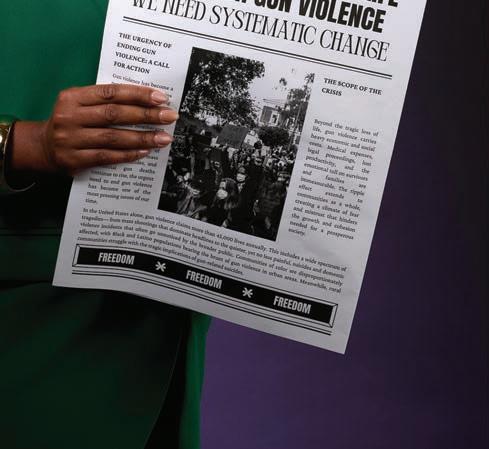



Executive director of development and community health, American Heart Association, Greater Cleveland
roughout her time with the American Heart Association (AHA), Shelley Webber has always known her “why” — the driving force behind her work at the nonpro t dedicated to ghting heart disease.
Her niece, who was born with a congenital heart defect, was undergoing her second open heart surgery in 2010 when Webber applied for a youth programming role in the Youngstown market.
“ e mission is very personal for me,” said Webber, who never expected her business major would lead her to nonpro t work. “Obviously, when you have a passion for something, it helps. And I love it. I love the organization. My favorite part of my job is working with donors and building those relationships. And so just kind of took o from there.”
In 2015, she joined the Greater Cleveland chapter as the director of the Heart Walk, an annual fundraising event that, under her leadership, grew to national recognition among AHA chapters.
Tom Hablitzel, an AHA board member who met Webber when she came to Cleveland, remembers her passion for the cause from the beginning. Her responsibilities have since grown, as she became vice president of development and, in January of this year, was promoted to executive director of development and community health.
“I’ve watched her grow into a leader of people, leading the organization and taking a bigger role in the big fundraising events,” Hablitzel said. “She’s kind of expanded her circles and her personal development, her reach in the community, and it’s been constantly growing.”
In the executive director role, Webber continues to oversee de-
velopment and is responsible for community impact and health goals for the market, including communication plans, interfacing with the local board of directors and implementing the strategy, vision and direction for American Heart Association in the Cleveland market.
During her tenure overseeing development, Webber has driven annual revenue increases and ended the scal year on June 30 at about $3.65 million, the most the market has ever raised and an 11% increase over the year prior.
“Since I managed development, I ‘ve been able to grow the market about $1.8 million over four years, which is really exciting,” Webber said. “A lot of that just working with the community volunteers, obviously, donors, being very strategic with opportunities for donors.”
Webber said she’s proud to help the association focus on social determinants of health, health equity and community health programs.
Having seen the research that AHA has funded, Webber has so much hope for her niece, now 18, who has no medical interventions left except a new heart and is working with a transplant team.
So many people like herself have a connection to heart disease and stroke and are passionate about helping, Webber said.
Dan Whalen is embarking on the next stage of his career as a real estate developer with a big calling card in his background. He shepherded the $150 million INTRO mixed-use apartment and retail complex in Ohio City from dream to reality.
Whalen worked for Chicagoarea real estate developer Harbor Bay Ventures while it developed the 298-unit apartment building with ve of its own hospitality concepts from other such projects elsewhere since 2018. is year, he took the typical step for young developers, launching his own company.
“It’s inevitable to go on your own if you do what I do,” Whalen said. “You have to raise the capital yourself if you want to do it right.”
Called Places, the Ohio Citybased concern is planning an eight-story boutique hotel on a parking lot that Whalen hopes to get going next year to ll a void he and others see on the West Side.
“ e idea is to have a social club and restaurant on the rst oor,” Whalen said, “and a hotel bar on the top oor, where the view of the city, downtown and the lake are superb.”
ough its rst project is a hotel, Places will focus on multifamily developments in both ur-



She has helped drive membership at the association ‘s two giving societies: the AHA Cor Vitae Society for donors who pledge annual gifts of $5,000 or more, and the Paul Dudley White Legacy Society for donors who leave the association in their will for estate planning. For three consecutive years, the chapter has ranked rst in dual society members nationwide.
“ at comes down to relationship stewardship, getting to know our donors, making sure that they ‘re having a very meaningful experience,” Webber said. “We’re meeting with them. We’re getting to know them. What their ‘why’ is.”
—Lydia Coutré



ban and suburban locations.
Whalen had the concept for INTRO and had secured the site at West 25th Street and Lorain when he met Harbor Bay principals while representing a restaurant concept that interested them.
“After they saw the inside of the West Side Market, they were in.” Whalen said.
At that point, Whalen had already put in his development apprenticeship. He got his start working for Snavely Group, the Chagrin Falls-based construction and real estate rm, while getting an MBA at Case Western Reserve University. en he spent time in Chicago with Starwood Retail Partners, the shopping center arm of Starwood Capital. Doing INTRO helped bring him home.
ose positions put him in the real estate development business from a quite di erent direction in life. He received a BA in English as an undergraduate at Case Western Reserve as a route to becoming a sportswriter. He was an All-American quarterback there after quarterbacking the team at his high school, Willoughby South.
“In my senior year, the coach said I had a chance to try out for the pros, something I really hadn’t thought about,” he said, so he gave it a go. “After getting cut from the Orlando Predators (arena football team) I decided to
Rhonda Winslow has one of the most unique nance jobs in the city.
Her path to becoming the Port of Cleveland’s vice president of development nance began with a bookkeeping internship turned job at a small Akron company.
“I wanted to be a teacher, but there was this opportunity where you could leave school a few hours early and go work in an ofce and there I took a liking tonance and accounting, so it was a good match,” she said.
Eventually, Winslow went to work in public accounting at Pricewaterhouse Coopers, where she fell in love with working in Cleveland.
“I loved working downtown,” Winslow said. “It was during the early stages of downtown changing, becoming a little more exciting. It was right before the casino was open but development on East Fourth was happening. It was a great time to be here.” at love for Cleveland’s renaissance helped lead her to the port, which, besides being one of the largest shipping ports on the Great Lakes, provides a unique set of nancing tools for developers.
“When I saw the job posting for the port, it felt like one of those

change directions.”
He chose realty development because he enjoyed envisioning projects. He also dropped the idea of sports writing after seeing his contacts from an internship at Sports Illustrated lose their jobs in a downsizing.
Tenacity is a strong suit for Whalen, according to his mentor Rob Namy, chief operating o cer of Weston Inc., the Warrensville Heights real estate rm, and friends who admire his taste in design, drive and quiet intensity.
“He’s all about perseverance,” Namy said. “He’s always talking about what he would like to see here or there. I’m glad to see him spreading his wings with his own rm. We need people like Dan to strengthen Cleveland.”
—Stan Bullard
meant-to-be-moments,” Winslow said. “I didn ‘t know the port existed or what it did, but the position kind of spoke to me.”
en-Port Chief Financial Ofcer Brent Leslie hired her as a project accountant, but also set up Winslow to shadow him for the rst couple of years, to learn the ins and the outs of the port’s complicated nancing programs.
Winslow learned all about the nuances of the port’s bonding and lending capacity and programs allowing the quasi-governmental agency to provide nonpro t organizations and developers tax-free purchase of construction materials.
When it came time for Leslie to leave his position, Winslow, who earned an MBA from the University of Akron, was asked to take over the nance development department.
Since then, Winslow has helped shepherd through billions in nancing on projects as big as the new downtown SherwinWilliams headquarters to one critically located Dave’s Supermarket in Midtown.
“It’s pretty expensive to build here and our rents are not quite commiserate with rents in other peer markets,” Winslow said.
“Developers can build a project and spend their money anywhere, so it is important to incentivize projects to get them done here.”
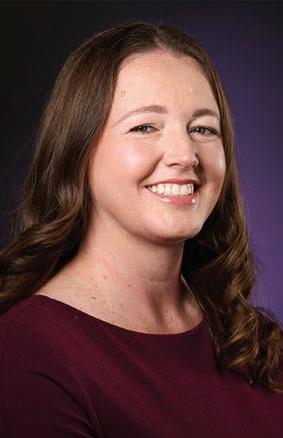
Winslow took over just as the pace of port nancing picked up, said Will Friedman, port president and CEO.
“Still, it is not easy to get these projects over the nish line. ere are hurdles all along the way with all the parties involved,” Friedman said. “You have di erent government entities, di erent lenders, service providers, lawyers and bankers working for the various parties on this deal.” roughout it all, Winslow, now a married mother of two young children, is always “a consummate professional,” Friedman said.
“She is a pleasure to work with, conscientious and un appable,” he said. “ e port closed on 90 or more deals this year, and it is because she is the backbone of the development nance program.”
—Kim Palmer
By Joe Scalzo
On Sunday, Nov. 3, a former Soviet computer engineer named Alexey Pajitnov stood in front of a large crowd at Lucca Comics and Games in Lucca, Italy, to celebrate the 40th anniversary of Tetris, the video game he developed while working at the Academy of Sciences of the Soviet Union in 1985.
Just before plunging his hands into wet cement for the event’s Walk of Fame, Pajitnov took off his jacket, revealing a cream-colored T-shirt featuring the game’s familiar building blocks and the word “Tetris” in the center.
The T-shirt was designed by ILTHY (“I’d Love To Help You”), a Cleveland-based art and apparel company that collaborated on a limited edition clothing collection with Tetris in mid-October.
Not a bad building block.
“It was pretty cool,” ILTHY CEO Kumar Arora said of Pajitnov’s moment. “For a Cleveland company to do Tetris’ 40th anniversary is huge.”
These are exciting times for ILTHY, which was established in 2010 by Arora and local artist Glen Infante and has grown about 350% since the pandemic, with inventory increasing about twelvefold, Arora said. Over the past few years, ILTHY has partnered with the city’s three professional sports teams, athletes such as LeBron James (who was seen in Paris wearing an ILTHY shirt, which immediately sold out) and Bernie Kosar, Cleveland musician Machine Gun Kelly, organizations like Nike and NASA, and another Gen X-era icon: Transformers.
And there’s a lot more to come. ILTHY has partnerships planned with the Cavs, Sega (for Sonic the Hedgehog 3, which is being released in December), the Atlanta Hawks, Market Garden Brewery and the NBA G-League, with more on the way next year.
“The next 18 months are going to be really exciting for us,” said Arora, whose offices are located at the intersection of East 25th and St. Clair near downtown. “And it’s cool to be able to be creative and do design from Cleveland of all places. You don't really see that. I spent some time in L.A., but since COVID, I've really rethought how the strategy of my personal and professional life could be. And it’s really just about finding homegrown talent and building it from here instead of a big city. That’s what makes ILTHY so cool.”


hoard it in your closet, but you don't think about the timelessness of a product, right?
“I spent a good couple of years, from COVID onward, on improving the product experience and quality, down to the details like the labeling. I think for us, we want to continue to innovate and really challenge the market. It doesn't have to be a basic T-shirt, you could wear something nicer that can stay in your closet for several years instead of being tossed in the corner.”
In May 2022, ILTHY partnered with the Guardians on a T-shirt giveaway, with the first 10,000 fans receiving a gray shirt that featured a new take on the script Guardians logo, as well as ILTHY’s heart bolt logo on the chest and its "Cleveland
Is the Reason" slogan on the sleeve. In fall 2023, ILTHY teamed up with the Browns for the first time on two apparel drops as part of the NFL's local merchandise collaboration initiative.
Last March, ILTHY and the Cavs partnered on a streetwear collection — complete with a photo shoot featuring Austin Carr and Mike Fratello — and ILTHY did another collaboration with the Browns before this year's home game against the Ravens.
“ILTHY’s bold, creative designs reflect the spirit of Cleveland and resonate with Browns fans,” Brent Rossi, the SVP of marketing and media for the Haslam Sports Group, wrote in an email to Crain’s Cleveland. “Our partnership over the last two seasons, which was made possible through the NFL's local merchandise collaboration initiative, has allowed us to offer pieces that are fresh and unique, while showcasing our team’s passion with the city’s culture. Browns fans everywhere have had an incredible reaction to this collaboration and are excited to wear something that represents both their love for their team and their personal style.”
Moving forward, Arora said he wants to continue to grow the company, but “do it in the right way.” That will likely involve adding some strategic investors since LTHY has been self-funded to this point, he said.
“I think we are now in a position where we've had so much support, and we are a force to reckon with,” he said. “We want to show people that things can be done differently, where there's an aspect of ‘feel good and wear good.’ Where you can feel proud to be a part of this brand because it means more than just a shirt or means more than just a design, that there is that aspect of contributing to society. I'm excited to be able to be in that position and lead this company in the next chapter of where we're going.”
ILTHY began as a pop-up concept with deep roots in street culture — ILTHY also stands for “I Love The Hype” — and it has since promoted streetwear on a much wider scale, working across projects that have elements of pop culture, nostalgia, hip-hop music and athletics. And an increasing number of those projects have a social impact element, Arora said. The Transformers collaboration, for instance, included a movie screening for kids and
toys that were donated to hospitals. ILTHY created an exclusive collection for the LeBron James Family Foundation, with proceeds going back to the organization. For the Tetris drop, ILTHY partnered with Arora’s tech conference, Futureland, to promote diversity in the city.
“The beauty is, these big legacy brands want to do that,” said Arora, whose organization has also supported The Littlest Heroes, the Greater Cleveland Food Bank and the Cleveland Metropolitan School District. “They want the storytelling, they want the homegrown story, and they want to give back. And what better way to do it with a company that's called
‘I'd Love to Help You’?”
ILTHY is also leaning into sustainability, with an emphasis on designing apparel that’s made to last and incorporates novel materials such as silicon 3D rubber, suede and puff inks.
“From a product development standpoint, we really started to pay attention to, ‘How do you make a more quality product that can last longer, that is something that's of value to be in your closet?’ ” said Arora, who describes himself as a “serial entrepreneur” as well as a designer, brand-builder, marketer and investor. “I think that apparel is often just kinda seen as a throwaway piece, and you just kinda
To place your listing, visit www.crainscleveland.com/people-on-the-move or, for more information, contact Debora Stein at 917.226.5470 / dstein@crain.com
Maloney + Novotny LLC
Ron Ambrogio joins Maloney + Novotny as the Firm’s Director of Business Development. His experience and expertise will impact the growth of the rm immediately. Previously, Ron was President of the Ohio Region at BNY Mellon Wealth Management, overseeing investment management, trust administration, and private banking. Before BNY, he was National Sales Manager and led the Wealth Management Credit Division at KeyBank.

Fifth Third Bank
Lutheran Metropolitan Ministry

Meaden & Moore
It is our pleasure to announce the promotion of Tyler Fries, CPA to Senior Manager! Tyler brings a decade of public accounting experience and is based in our Cleveland of ce. Known for his commitment to exceptional service, working with clients across construction, manufacturing, employee bene ts, and not-for-pro t sectors. He helps clients maintain compliance and improve operational ef ciency, making him a highly valued member of the Meaden & Moore team.


Meaden & Moore
It is our pleasure to announce the promotion of Darby Melville, CPA to Senior Manager! With nearly 10 years of public accounting experience, Darby works out of our Akron of ce, delivering assurance services to clients in a variety of industries. Darby is passionate about delivering value by working closely with clients and their accounting teams to identify and address problem areas. His dedication to quality and client satisfaction makes him an integral part of the Meaden & Moore team.


Fifth Third Bank has named Keith Baron as vice president, commercial relationship manager. In this role, he is responsible for driving the Bank’s growth in the commercial middle market space within Northeast Ohio. Keith has over 20 years’ experience in commercial banking, debt placement and nance experience. He earned a bachelor’s degree in economics from Ohio University and a master’s in business administration from Case Western Reserve University’s Weatherhead School of Management.
Fifth Third Bank

Hickman Lowder Lidrbauch & Welch Co., L.P.A. Hickman Lowder Lidrbauch & Welch Co., L.P.A. is pleased to announce that attorney Riley A. Williams has joined the rm in our new Independence, Ohio of ce. She will concentrate her practice on special needs estate planning and asset protection as well as Elder Law, including Medicaid planning. https://www.hickmanlowder.com/attorney/williamsriley-a/

Michael Sering has worked for LMM for 30 years, beginning with LMM’s Community Reentry Program. Sering’s role grew to become the VP of Housing & Shelter where he oversaw all Men’s Shelter operations, partnerships, and staf ng, as well as the Family Over ow shelter for Cuyahoga County. Sering also launched LMM’s portfolio of affordable housing in 2015, to include shared and family housing, and other innovative solutions to homelessness. As CPO, Sering now oversees programs and services at LMM.


Cleveland Hopkins among affected airports as aircraft delivery delays force carrier to trim ights
By Mary Schlangenstein, Bloomberg

Anderson|Biro Staf ng
Southwest Airlines Co. will offer voluntary departure packages or extended leaves to airport workers in 18 cities and at its headquarters as aircraft delivery delays force the carrier to trim its flying plans.

Fifth Third Bank has named Vince Iosue as vice president, commercial relationship manager. In this role, he is responsible for driving the Bank’s growth in the commercial middle market space within Northeast Ohio. Vince has 12 years of banking experience in corporate and commercial banking roles. He earned a bachelor’s degree in accounting from Westminster College.


Hakmat Manaa is an associate in Taft’s Real Estate practice. She has experience assisting clients in all matters relating to real estate acquisitions and disposal, leasing, land use and zoning, and nancing matters. Hakmat earned her J.D. from Case Western Reserve University School of Law and her bachelor’s degree, summa cum laude, from Cleveland State University. Rachel Wilson is an associate in Taft’s Commercial Litigation and Labor and Employment practices. Rachel earned her J.D., magna cum laude, from Cleveland State University College of Law, and her bachelor’s degree, magna cum laude, from Ashland University.

Contact: Laura Picariello Sales Manager

Anderson|Biro Staf ng is pleased to announce and congratulate Tracy Walsh on her promotion to AVP, Senior Recruiter and Equity Stakeholder. Tracy joined the Anderson|Biro Staf ng team in 2021 and is now considered a cornerstone of our success and expansion. Tracy represents the personi cation of an experienced staf ng professional highlighted by her extensive success across the Of ce Professional, Technical and Light Industrial sectors we serve. Thank you, Tracy!

National Mortuary Shipping & Cremation
The offers will be extended to airport ground workers such as customer service, ramp and operations agents, as well as cargo employees and their supervisors in some cases, the company said in a statement on Nov. 11.
One source within the airline industry shared a memo that included the airports that are part of the buyout and it includes ramp agents at Cleveland Hopkins International Airport.
Southwest later confirmed to Crain's that Cleveland was included in the offer.
A spokesperson for Southwest said in a statement sent via email, "Southwest has reduced overall capacity to meet demand with a constrained fleet due to aircraft delivery delays. Offering voluntary separation and extended time off to contract and noncontract Employees, along with continued slowed hiring, will help us avert overstaffing in certain locations."

National Mortuary Shipping and Cremation is excited to announce the promotion of Mallory Berwald to Business Development Specialist. Mallory began her career at NMS in 2022 as a shipping specialist and has developed many relationships with customers and agents providing them with the service NMS is known for. Berwald has excelled in many of the projects she has assumed. She recently acquired her Crematory Operators Permit in the state of Ohio and has rebranded NMS’s local pet crematory.


According to a report from the Dallas Morning News, pilots are not included in the offer. Rather, it's been extended to workers including, "ramp agents, customer service agents, cargo workers and operations agents."
Southwest didn’t immediately say how many workers will receive the offers, which will be shared this month. Those who accept will leave the airline at the end of the year, the airline said.
Southwest is grappling with expensive new labor contracts and a slowdown in Boeing Co.’s ability to deliver aircraft on schedule, which have increased costs. The carrier has said it will receive just 20 new planes this year, down from an earlier expectation of 79. It won’t get any long-awaited 737 Max 7s, forcing it to delay the retirement of older planes.
Crain's Cleveland contributed to this report.





























